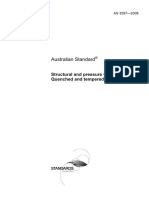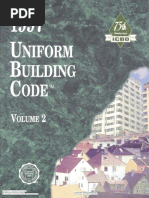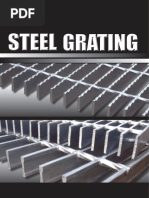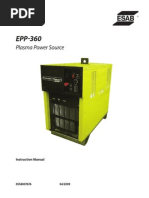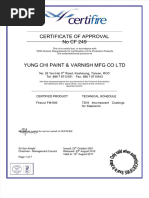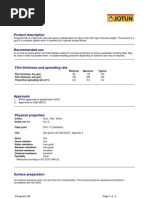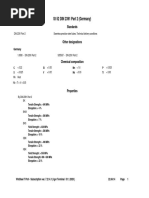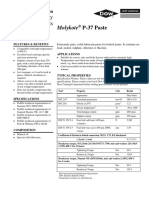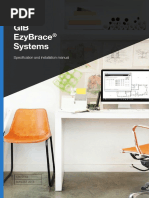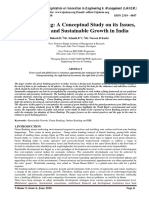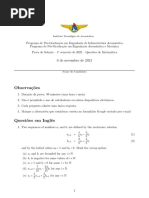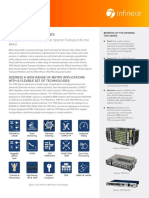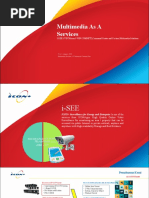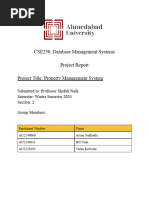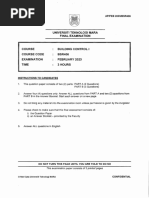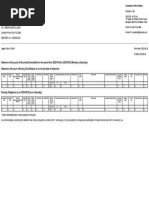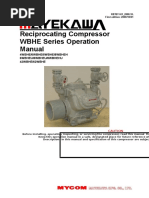Gib Bracing
Gib Bracing
Uploaded by
Stefan ReutherCopyright:
Available Formats
Gib Bracing
Gib Bracing
Uploaded by
Stefan ReutherCopyright
Available Formats
Share this document
Did you find this document useful?
Is this content inappropriate?
Copyright:
Available Formats
Gib Bracing
Gib Bracing
Uploaded by
Stefan ReutherCopyright:
Available Formats
CBI 5113 March 2006
GIB Bracing Systems
www.gib.co.nz
GIB Bracing Systems, March 2006 Winstone Wallboards Ltd accepts no liability if GIB Bracing Systems are not used in accordance with instructions contained in this publication. Use Only the Current Specification This publication may be superseded by a new publication. Winstone Wallboards Ltd accepts no liability for reliance upon publications that have been superseded. Before using this publication check whether this is the current publication, simply call the GIB Helpline on 0800 100 442 or visit www.gib.co.nz Substitution GIB Bracing Systems are not generic. Where specified, GIB branded components must be used when specifying and installing GIB Bracing Systems. Substitution is not in accordance with the instructions contained in this publication. Copyright Copyright Winstone Wallboards Ltd 2006. All of the material contained in this brochure, including all text, tables, charts, graphs, drawings, fastener patterns, diagrams and the EzyBrace Specification Numbering System (and the sub-components thereof), are protected by copyright. These materials may not be reproduced, adapted or transmitted in any form by any process, without the permission of Winstone Wallboards Ltd. Winstone Wallboards also reserves all other intellectual property rights in the materials contained in this brochure. Acknowledgements WIND and EARTHQUAKE design Tables and Figures were reproduced from NZS 3604:1999 with kind permission from Standards New Zealand (SNZ). The copyright remains the property of SNZ. Your attention is drawn to the copyright infringement notice contained in NZS 3604:1999. Assistance was provided by BRANZ with the design of the procedure for determination of the WIND ZONE.
BRANZ Appraisal Certificate No. 294 (2006) GIB Bracing Systems, 2006
GIB BRACING SYSTEMS
Table of Contents
MARCH 2006
Scope of Use Compliance with the New Zealand Building Code (NZBC) Appraisal Limitations GIB Bracing Systems in Water-Splash Areas Renovation How to use this Document
GIB Bracing System Changes .................................................................................................................................................................................................................. Introduction ................................................................................................................................................................................................................................................................................
Page
3 4
DESIGN Design Step 1 Wind
5-8
The Wind Zone Wind Region Terrain Site Exposure Topographic Classification Working out the Bracing Units (BUs) Required for Wind
The Earthquake Zone Working out the Bracing Units (BUs) Required for Earthquake Roof Space Areas
Design Step 2 Earthquake ...........................................................................................................................................................................................................................
Wall Heights other than 2.4m GIB Bracing Systems EzyBrace Specification Numbering System Panel Hold-downs Bracing Units (BUs) achieved Wind and Earthquake
Design Step 3 Distribution of Wall Bracing Elements Design Steps 4 and 5 Bracing Units Achieved (Wind & Earthquake)
10
................................................................................
1213
Wall Bracing Calculation Sheets
Tables W1a, W1b
............................................................................................................................................................................................................
1415 16 1722
BRACING DEMAND TABLES WIND ............................................................................................................................................................................................... BRACING DEMAND TABLES EARTHQUAKE
Tables EQ1, EQ2, EQ3, EQ4, EQ5, EQ6
...............................................................................................................................................................
CEILING DIAPHRAGMS .......................................................................................................................................................................................................................................... 24-25 Ceiling Diaphragms Ceiling Diaphragms Steel Battens
GIB Bracing System Changes Framing Fastening GIB Plasterboard Linings Plywood Fire Resistance and Noise Ratings Jointing and Stopping Fastening the Bracing Element to Timber Floors Fastening the Bracing Element to Concrete Slabs Panel Hold-Down Details Openings in Bracing Elements GIB Bracing Systems in Water-Splash Areas Renovation Angle Braces Top Plate Connections Guidelines for Intersecting Walls Fixing the Perimeter of a Bracing Element Fixing in the Field of the Bracing Element Horizontal Fixing GIB Bracing Systems EzyBrace Specification Numbering System
CONSTRUCTION DETAILS.................................................................................................................................................................................................................................. 26-28
GIB BRACING SYSTEMS
Panel Hold-Down Details (illustrations) ............................................................................................................................................................................................... Fastener Layouts GIB Standard Bracing Elements (illustrations) ................................................................................................ Fastener Layouts GIB Braceline Bracing Elements (illustrations) ............................................................................................... GIB Bracing Systems Installation Checklist ...................................................................................................................................................................
FOR FURTHER INFORMATION VISIT WWW.GIB.CO.NZ
29 30 31 32
GIB BRACING SYSTEMS
Changes to GIB Bracing Systems
GIB Bracing Systems Changes
MARCH 2006
GIB Bracing Systems have undergone a thorough review as part of Winstone Wallboards ongoing programme to make GIB systems simpler, easier and faster for customers to use. Users of the previous systems will notice some significant changes. Please review this technical literature in detail to make yourself aware of these changes. The key differences are as follows: The new EzyBrace Specification Numbering System is designed to make specification, installation and identification of GIB Bracing Systems easier. A rationalised number of bracing element types and a more consistent construction method. Fasteners must not be placed closer than 18mm to a sheet end or a cut edge or no closer than 12mm to the tapered (paper bound) machine edge of the GIB plasterboard sheets. Some hold down details and corner fastening details have changed. A new 35mm GIB Braceline Nail replaces the 32mm GIB Braceline Nail in GIB Braceline bracing elements. GIB plasterboard sheets used in GIB Bracing Systems March 2006 must have a manufacturing date after 16 January 2006. No additional framing is required for narrow panels. Introduction of a shorter 0.4m bracing element. Ability to substitute GIB Aqualine for GIB Braceline with modified fastener patterns. Note: The bracing systems in the GIB Bracing Systems 1999-2003 technical literature will remain valid, however, transfer to the systems contained in this publication is recommended for new designs for the benefits these systems offer.
FOR FURTHER INFORMATION VISIT WWW.GIB.CO.NZ
GIB BRACING SYSTEMS
3
GIB BRACING SYSTEMS
Introduction
MARCH 2006
Scope of Use This document is a guide to wall bracing of buildings constructed in accordance with NZS 3604:1999, Standard for Timber Framed Buildings not requiring specific design. It is for owners, architects, engineers, draftsmen and builders, and designed to help the user to determine a buildings wall bracing needs. It explains how to use GIB Bracing Systems to resist wind and earthquake forces. The information contained in this document is believed to be correct and accurate. However, all due care should be exercised by those who use it. If necessary, appropriate advice should be sought. Winstone Wallboards Ltd accepts no liability if the system is not used in accordance with instructions contained in this literature. Compliance with the New Zealand Building Code (NZBC) GIB Bracing Systems comply with the requirements of NZS 3604:1999, when designed and installed in accordance with this brochure. NZS 3604:1999 is an Acceptable Solution to NZBC Clause B1 Structure. Under normal conditions of dry internal use GIB Bracing Systems have a service life in excess of 50 years and satisfy the requirements of NZBC Clause B2 Durability. Appraisal The document entitled GIB Bracing Systems has been appraised by BRANZ Ltd. BRANZ Appraisal Certificate No. 294 (2006). Limitations GIB plasterboard must be stacked flat and protected from the weather. GIB plasterboard must be handled as a finishing material. GIB plasterboard in use must not be exposed to liquid water or be installed in situations where extended exposures to humidities above 90% RH can reasonably be expected. GIB Bracing Systems must not be used in showers or shower over bath situations. It is highly recommended not to install GIB plasterboard in any situation where external claddings are not in place or the property is not adequately protected from the elements. If GIB plasterboard is installed under these conditions, the risk of surface defects such as peaking or cracking is greatly increased. GIB Bracing Systems in Water-Splash Areas When GIB plasterboard is installed in locations likely to be frequently exposed to liquid water it must have an impervious finish. Examples are adhesive fixed acrylic shower linings over GIB Aqualine with an approved waterproof membrane as a substrate for ceramic tiles. The NZBC requires 15 years durability in these situations. Bracing elements are required to have a durability of 50 years. Winstone Wallboards recommends that bracing elements are not located in shower cubicles or behind baths because of durability requirements, the likelihood of renovation, and practical issues associated with fixing bracing elements to perimeter framing members. Otherwise GIB Bracing Systems can be used in water-splash areas as defined by NZBC Clause E3, provided these are maintained impervious for the life of the building.
No bracing in the shaded areas
Renovation When relining walls during the process of renovation, ensure that bracing elements are reinstated (check the building plans). How to use this Document This document will guide you through the process of designing a bracing system and filling out a bracing schedule in accordance with NZS 3604:1999 step by step. Where reference is made to the GIB Site Guide, use the latest version.
External forces (Bracing Units (BUs) required or demand)
Step 1: Work out the required number of BUs for wind
Step 2: Work out the required number of BUs for earthquake
The structures resistance (Bracing Units (BUs) achieved or capacity)
GIB BRACING SYSTEMS
Step 3: Ensure adequate distribution of wall bracing elements
Step 4: Work out the achieved number of BUs for wind
Step 5: Work out the achieved number of BUs for earthquake
FOR FURTHER INFORMATION VISIT WWW.GIB.CO.NZ
GIB BRACING SYSTEMS DESIGN
Design Step 1 Wind
The Wind Zone
Determining the wind zone for a particular building site can be a complicated step in preparing a bracing schedule. Some territorial authorities already have wind zoning maps prepared to assist designers. Ring your local building office to find out. If the information is not available, the wind zone can be worked out by following the simple procedure below. The wind forces that act on a building depend on the wind region, the terrain roughness, the site exposure, and the topography. By considering these four variables individually and assigning points, based on severity of wind loading, the total number of points scored will determine the site wind zone;
POINTS WIND ZONE
MARCH 2006 Wind Region
+
Terrain Roughness
+
Site Exposure
+ =
Topographic Classification Wind Zone
0 1 2 3 4 or more
Low Medium High Very High Specific Design
(L) (M) (H) (VH) (SD)
R2 R2
Warkworth
Snells Beach
Wind Zone Variable 1: Wind Region (R1/R2)
New Zealand is divided into wind regions as illustrated in Figure W1. i ii The majority of the country is classified R1. Strong winds commonly occur in the extreme regions of both islands and these regions are classified R2.
Auckland Thames Morrinsville
R1
Lee zone
Determine the wind region from Figure W1 and assign points as follows: R1 = 0, R2 = 1 Note: Shaded areas in Fig W1 must have a topographic classification of at least moderate.
R1
New Plymouth
Turangi Ohakune Waiouru
R1
Wellington
Blenheim
Wind Regions Fig W1
R1
Hanmer Springs
R2
Kaikoura Culverden
Haast
Christchurch Methven Twizel
Paraparaumu
Waikanae
R2
Cromwell Alexandra
R1
Manor Park
Pinehaven
GIB BRACING SYSTEMS
5
R1
Lake Ferry
R2 R2
Dunedin
FOR FURTHER INFORMATION VISIT WWW.GIB.CO.NZ
GIB BRACING SYSTEMS DESIGN
Design Step 1 Wind cont.
Wind Zone Variable 2: Terrain (Inland/Coastal)
The roughness of the terrain over which the wind must pass before it reaches the building site slows down the wind speed. i The site is classified as coastal terrain if within 500m of the sea coast, open water, or the edge of coastal mudflats, flat beaches, airfields, etc. Note: Open water includes lakes, rivers and inland waterways wider than 300m. Sites not within the coastal terrain are classified as inland.
MARCH 2006
Coastal 500m
Inland
ii
Determine the terrain category and assign points as follows: Inland = 0, Coastal = 1
Wind Zone Variable 3: Site Exposure (Sheltered/Exposed)
Nearby obstructions will provide shelter to a proposed building from wind coming over open parks, motorways, rivers, or other open spaces greater than 100m wide. i At least two rows of similarly sized, permanent obstructions in each upwind direction are required for the site to be considered sheltered.
Sheltered
Exposed
If the proposed building does not receive such shelter from nearby obstructions then it should be classified as exposed (e.g., a clear unobstructed view from the ground floor level over neighbouring buildings). Note: In situations such as growing sub-divisions, the site exposure may be based on the expected conditions five years hence. ii Determine the site exposure and assign points as follows: Sheltered = 0, Exposed = 1
Wind Zone Variable 4: Topographic Classification (Gentle/Moderate/Extreme)
The topography of the land will affect the wind flow, e.g., hill top sites will receive higher wind loadings than sites on the flat. i Sites with a gentle classification are; Sites on flat land or undulating hills less than 20 metres high, Sites on the lower slopes of hills which have a slope flatter than 1:5. The gentle classification covers the majority of building sites in New Zealand. Sites with a moderate classification are; Sites more than 20 metres above a valley floor, Sites within 150 metres of the crest of a hill, ridge or spur which has a slope flatter than 1:5, Sites on the crest of an escarpment.
ii
Notes to assist with the determination of the topographic classification: Establishing heights is easiest from contour maps of your local area. Your councils building office may be able to assist. To determine the topography, select the landform that best fits your building site. Cross sections should be taken so that they represent the worst case (i.e., steepest slope). Remember that it is impossible to capture NZs topography in a few simple sketches. Your judgement is sometimes required. If in doubt, talk to your local councils building office. On hill slopes steeper than 1:5, roads and driveways will tend to follow the contour. On flatter slopes they tend to take the shortest route up the hill. 20 metres is approximately 3 times the height of a two storey house.
GIB BRACING SYSTEMS
iii Sites with an extreme classification are; Sites within 250 metres of the crest of a hill, ridge or spur which has a slope steeper than 1:5, Sites at the head of a valley. Note: Some small pockets where there is known evidence of strong winds as a result of specific local land formations are identified on Figure W1. These must be classified at least moderate. Determine the site topography and assign points as follows: Gentle = 0, Moderate =1, Extreme = 3
FOR FURTHER INFORMATION VISIT WWW.GIB.CO.NZ
GIB BRACING SYSTEMS DESIGN
Design Step 1 Wind cont.
Topographic classification Gentle Moderate Extreme Gentle Moderate
MARCH 2006
Gentle
150m 150m or less or less Highest point Ridge or spur, flatter than 1 in 5 Gentle Gentle Moderate Moderate 150m or less 250m or less 20m 20m
20m
Hillside, steeper than 1 in 5 Gentle
Escarpment
Valley floor
Gentle
Gentle
Moderate 150m or less
20m
Undulating hills Moderate Extreme Moderate Moderate Spur beyond 250m 250m or less or less Highest point
Hillside, flatter than 1 in 5 Extreme 250m
Ridge or hilltop, steeper than 1 in 5
Head of Valley
FOR FURTHER INFORMATION VISIT WWW.GIB.CO.NZ
GIB BRACING SYSTEMS
7
e Vall
Highest point
Highest point
GIB BRACING SYSTEMS DESIGN
Design Step 1 Wind cont.
Working Out the Bracing Units (BUs) Required for Wind
When the wind zone has been established you can work out the total number of BUs required to brace the structure against wind loads. You need to consider bracing in two directions, along and across the building. Table W1a (page 16) lists the BUs needed for wind and applies to a single storey building, or the top storey of a two storey building. Table W1b (page 16) lists the BUs required for a lower storey of a two storey building. Both tables list the number of BUs required per metre of building length or width. Normally the buildings length and width can be taken off the building plans at floor level. However, when the roof pitch is greater than 25 degrees the buildings length and width are taken at eaves level, i.e., the floor plan dimensions plus any eaves overhang. This is because such steep roofs become the dominant target for wind. From the tables, i ii Select the overall height of the building (height to apex) determine the roof height above the eaves
MARCH 2006
Al
on
Ac
ros
BL
ro o
fo
ve
r2
iii determine the stud height (2.4 or 3.0m) iv select the appropriate wind zone column i, ii and iii will give you a horizontal row on the table. iv will narrow the answer down to two readings:
BL
5O
BW
roo
fo
r ve
25
BW
for calculating BUs across for calculating BUs along
Roof Apex Stud height
GIB BRACING SYSTEMS
8 FOR FURTHER INFORMATION VISIT WWW.GIB.CO.NZ
GIB BRACING SYSTEMS DESIGN
Design Step 2 Earthquake
The Earthquake Zone
The potential earthquake loading on structures is more severe in some areas of New Zealand than it is in others. Figure EQ1 divides the country in three earthquake zones, A, B and C. Look at the map to determine your earthquake zone. Select earthquake zone A/B/C.
Pokeno
MARCH 2006
C
Whenuakite Te Puru Miranda Thames Mercer
Auckland
Working Out the Bracing Units (BUs) Required for Earthquake
When you have found your earthquake zone use Tables EQ1-6 (pages 17-22) to determine the number of BUs required to brace the building against earthquake loads. The weight of building materials is important. This is reflected in tables EQ1-6. Heavy claddings and roofs mean more BUs required. i The first three columns have combinations of subfloor, wall and roof cladding weights. Select the category that best fits the building. Select the roof slope from the 4th column.
B
Te Kuiti New Plymouth
Tauranga Tokoroa
Wellington
Greymouth Hokitika
A
Lake Coleridge Christchurch
ii
iii Select the earthquake zone. You will now be able to read the number of BUs required. This number represents the BU requirement per square metre. Work out the number of BUs needed by multiplying this number per square metre by the building plan area measured at floor level. In an earthquake the ground motion can be in any direction so it is the same buildings weight which gets rocked around. The BU requirements for earthquake are therefore the same in both the along and across directions.
Timaru
C
Leithfield Sefton
A B
B
Dunedin Balclutha
Waimate Oamaru
Mosgiel
Lincoln Burnham Dunsandel
Governors Bay Taitapu
Earthquake Regions Fig EQ1
Roof Space Areas
Up to 50% of the roof space area may be developed into attic rooms. If this is the case, then the BU requirements per m2 of floor area measured at ground level (as derived from table EQ1 EQ6) must be increased by 3 BUs per m2. If more than 50% is developed, then the roof space must be considered as an additional storey and the storey below becomes a lower of two.
FOR FURTHER INFORMATION VISIT WWW.GIB.CO.NZ
GIB BRACING SYSTEMS
9
GIB BRACING SYSTEMS DESIGN
Design Step 3 Distribution of Wall Bracing Elements
When the number of BUs required for wind and earthquake in both the along and across directions have been worked out, the next task is to allocate wall bracing elements on the building plan by using external and internal walls lined with GIB plasterboard. Distribution of bracing is done by drawing an imaginary grid pattern of bracing lines along and across the building. These should be numbered A,B,C, etc. in the along direction and M,N,O etc. in the direction across the building. These bracing lines must coincide as much as possible with the wall bracing elements. External walls are supported horizontally by bracing lines at right angles. If those supports are spaced too far apart, then the external wall could suffer unacceptable deformation. For this reason the following maximum spacing of bracing lines must be adhered to, i ii 5 metres for standard construction or 6 metres if a double top plate, as illustrated opposite, stiffens the external wall
MARCH 2006
C M
2m max
N
Along Across
O
2m max
iii 7.5 metres with a GIB Standard plasterboard ceiling diaphragm, or 7.5 metres when dragon ties in accordance with NZS3604:1999 are used iv 10 metres with a GIB Ultraline ceiling diaphragm v 15 metres with a GIB Braceline ceiling diaphragm (For ceiling diaphragms see pages 24, 25) Each bracing line must contain a minimum number of bracing units as follows, i external walls 10 BUs per metre and at least 100 BUs total when dragon ties or a ceiling diaphragm are attached internal walls 70 BUs total, or 100 BUs when supporting a ceiling diaphragm
M
5m max
single 100 x 50 top plate
ii
M
6m max
Pairs of wall bracing elements can be a maximum of 2 metres either side of a bracing line, and count for the total number of BUs on that line. Try and achieve an even distribution of bracing throughout. A building which is heavily loaded with bracing at one end and lightly braced at the other, is likely to suffer damage through rotation under severe wind or earthquake loads. Locate bracing in or near external building corners. If it is not practical to locate bracing in corners due to windows, etc., then it is desirable to make the first lined wall section adjacent to the window a wall bracing element. Wall bracing elements can be at an angle to a bracing line and contribute in both directions. For 30, 45 and 60 degree angles the rating of the wall length L must be multiplied by reduction factors as follows, ii 45 degrees x 0.70
0.5 x L
150 x 40 plus 100 x 50 top plate
0.7 x L
30 degrees x 0.87
iii 60 degrees x 0.50
GIB BRACING SYSTEMS
60O
30O 0.87 x L
45O 0.7 x L
10
FOR FURTHER INFORMATION VISIT WWW.GIB.CO.NZ
GIB BRACING SYSTEMS DESIGN
Notes
MARCH 2006
FOR FURTHER INFORMATION VISIT WWW.GIB.CO.NZ
GIB BRACING SYSTEMS
11
GIB BRACING SYSTEMS DESIGN
Design Steps 4 and 5 Bracing Units Achieved (Wind and Earthquake)
MARCH 2006
The next step is to place selected wall bracing systems on the bracing lines. A range of GIB Bracing Systems have been tested and the specifications and Bracing Unit ratings are listed on the next page. GIB Standard Plasterboard systems often represent the majority of the wall bracing elements. GIB Braceline systems are used for narrow walls or when high Bracing Unit ratings are required.
Wall Heights other than 2.4m
The published Bracing Unit ratings are based on a 2.4 metre height. For other heights, the ratings must be multiplied by a factor f = 2.4 divided by actual wall height. The Bracing Unit ratings for walls higher than 2.4 metres will reduce, and the Bracing Unit rating for lower walls will increase. Factor f must not be greater than 1.3. For example: The Bracing Unit rating of a 2.7 metre high wall is obtained by multiplying the values in Tables 1 and 2 by f = 2.4/2.7 = 0.89 The Bracing Unit rating of a 3.6 metre high wall is obtained by multiplying the values in Tables 1 and 2 by f = 2.4/3.6 = 0.67 The Bracing Unit rating of a 2.0 metre high wall is obtained by multiplying the values in Tables 1 and 2 by f = 2.4/2.0 = 1.2 The Bracing Unit rating of a 1.5 metre high wall is obtained by multiplying the values in Tables 1 and 2 by f = 2.4/1.5 = 1.6. However, note that f is not permitted to be greater than 1.3, so adopt f = 1.3. The height of walls with a sloping top plate can be taken as the average height.
GIB Bracing Systems EzyBrace Specification Numbering System
The EzyBrace Specification Numbering System is designed to make specification of GIB Bracing Systems by designers and identification on site by builders and building officials more transparent. Note: The EzyBrace Specification Numbering System (and sub-components thereof) are protected by copyright. GS BL BLP BLG 1 2 a = = = = GIB Standard Plasterboard GIB Braceline GIB Braceline / Plywood GIB Braceline / GIB Standard Plasterboard
= lined one side = lined both sides = angle brace
Therefore, GS1a = GS2 = BL1 = BL1a = BLP = BLG = GIB Standard Plasterboard one side with an angle brace GIB Standard Plasterboard both sides GIB Braceline one side GIB Braceline one side with an angle brace GIB Braceline one side, Plywood on the other GIB Braceline one side, GIB Standard Plasterboard on the other
Panel Hold-downs
Panel hold-down details are illustrated on page 29. GIB Standard Bracing Systems (GS1a and GS2) do not require hold-downs. All bracing systems incorporating GIB Braceline require a panel hold-down at both ends of the bracing element.
GIB BRACING SYSTEMS
Copyright Winstone Wallboards Ltd 2006. All of the material on this document, including all text, tables, charts, graphs, drawings, fastener patterns, diagrams and the EzyBrace Specification Numbering System (and the sub-components thereof), are protected by copyright.
FOR FURTHER INFORMATION VISIT WWW.GIB.CO.NZ
12
GIB BRACING SYSTEMS DESIGN
Design Steps 4 and 5 Bracing Units Achieved (Wind and Earthquake)
TABLE 1:
TYPE
MARCH 2006
Bracing Unit Ratings for 10mm GIB Standard Plasterboard and any other 10mm and 13mm GIB plasterboard.
LENGTH (m) MINIMUM 1.8 LINING REQUIREMENT OTHER REQUIREMENTS DIAGONAL BRACE BU PER METRE WIND 65 10mm GIB Standard Plasterboard one face fixed horizontal or vertical 2.4 1.2 yes 75 70 10mm GIB Standard Plasterboard both sides fixed horizontal or vertical1 no 80 90 65 60 70 80 EARTHQUAKE 55
GS1a
GS2
1.8 2.4
TABLE 2:
Bracing Unit Ratings for 10mm GIB Braceline, 10mm GIB Noiseline and 10mm GIB Toughline (fixed with GIB Braceline screws or GIB Braceline nails)
LENGTH (m) MINIMUM 0.4 LINING REQUIREMENT OTHER REQUIREMENTS DIAGONAL BRACE no GIB Braceline one face fixed horizontal or vertical2 0.6 no yes HOLD-DOWNS yes yes yes BU PER METRE WIND 120 125 130 145 no yes 145 145 no yes 1503 130 145 130 EARTHQUAKE 115 115 115 135
TYPE
BL1
BL1a
1.8 0.6
GIB Braceline one face fixed horizontal or vertical2 GIB Braceline one face fixed horizontal or vertical, 7mm D-D plywood on the other1,2
BLP 0.9 0.6 BLG 1.2
GIB Braceline one face, 10mm GIB Standard on the other face, linings fixed horizontal or vertical1,2
Notes:
In order for GIB systems to perform as tested, all components must be installed exactly as prescribed. Substituting components produces an entirely different system and may seriously compromise performance. Follow system specifications. Copyright Winstone Wallboards Ltd 2006. All of the material on this document, including all text, tables, charts, graphs, drawings, fastener patterns, diagrams and the EzyBrace Specification Numbering System (and the sub-components thereof), are protected by copyright.
FOR FURTHER INFORMATION VISIT WWW.GIB.CO.NZ
GIB BRACING SYSTEMS
13
1) Where linings are specified on both faces, each face must be fastened as a bracing element. 2) GIB Aqualine can be used in place of GIB Braceline in bracing elements 900mm or longer, provided the perimeter of the element is fixed with GIB Braceline nails or screws spaced at 100mm centres generally, using the GIB Braceline corner fixing pattern. 3) A maximum of 150 BU/m is recommended for any bracing system used with NZS 3604:1999 construction. Higher ratings generate loads beyond the capacity of NZS 3604:1999 timber foundation and slab details. If ratings exceed 150 BU/m, hold downs and foundations must be the subject of specific structural engineering design.
GIB BRACING SYSTEMS DESIGN
Wall Bracing Calculation Sheet A
Job Details
Please Photocopy Name Street and Number Lot and DP Number City/Town/District Location of Storey: Building height to apex Roof height above eaves Stud height Average roof pitch Building length BL = Building width BW = single/upper of two/lower of two m m m m m Roof weight Cladding weights: Subfloor Lower Storey Upper Storey Room in Roof Space Gross Building Plan Area, GPA =
MARCH 2006
box 1
Floor load: 2kPa/3kPa light/heavy light/medium/heavy light/medium/heavy light/medium/heavy Yes / No
m2
Note: When the average roof pitch is over 25 degrees, use the eaves length and width to determine BL and BW.
Wind Zone
Region: R1 R2 Total points Wind Zone: Low Medium High (0) (1) (2) Very high Specific Design (3) (4) 0 1 Terrain: Inland Coastal 0 1 Exposure: Sheltered Exposed 0 1 Topography: Gentle Moderate Extreme 0 1 3
box 2
Earthquake Zone
From figure EQ1 select Earthquake Zone: A B C
box 3
BUs required Wind
From Table W1A/W1B W along = W across = Total wind load, W ALONG: W along x BW = W ACROSS W across x BL =
GIB BRACING SYSTEMS
box 4
BUs required Earthquake
From Table EQ1/EQ2/EQ3/EQ4/EQ5/EQ6 E= BUs/m2
box 5
BUs/m BUs/m
Note: For a room in the roof space use E + 3 Total earthquake load, BUs BUs EQ ALONG and EQ ACROSS E x GPA BUs = BUs
For a GIB EzyBrace software version visit www.gib.co.nz
FOR FURTHER INFORMATION VISIT WWW.GIB.CO.NZ
14
GIB BRACING SYSTEMS DESIGN
Wall Bracing Calculation Sheet B
Along
Please Photocopy
WALL OR BRACING LINE 1 Line Label 2 Minimum BUs Required 3 Bracing Element No. BRACING ELEMENTS PROVIDED 4 Bracing Type 5 Length Element (m) L 6W Rating BU/m W WIND 7W BUs Achieved (BU/m x L) W
MARCH 2006
EARTHQUAKE 6E Rating BU/m E 7E BUs Achieved (BU/m x L) E
Totals Achieved From Sheet A Wreq/Ereq = Totals Required *
W W
E E
* If Wreq/Ereq is 1 or less complete E column only If Wreq/Ereq is 1.2 or more complete W column only Otherwise complete both W and E
Across
WALL OR BRACING LINE 1 Line Label 2 Minimum BUs Required 3 Bracing Element No. BRACING ELEMENTS PROVIDED 4 Bracing Type 5 Length Element (m) L 6W Rating BU/m W WIND 7W BUs Achieved (BU/m x L) W EARTHQUAKE 6E Rating BU/m E 7E BUs Achieved (BU/m x L) E
Q GIB BRACING SYSTEMS
15
Totals Achieved From Sheet A Wreq/Ereq = Totals Required *
W W
E E
For a GIB EzyBrace software version visit www.gib.co.nz
FOR FURTHER INFORMATION VISIT WWW.GIB.CO.NZ
GIB BRACING SYSTEMS BRACING DEMAND TABLES WIND
Single or Upper Storey/Lower Storey of Two
W1a Single or Upper Storey
HEIGHT TO APEX (m) All ROOF HEIGHT (m) (ABOVE EAVES) 1 2 3 4 5 6 7 8 1 2 3 4 5 6 7 8 STUD HEIGHT (m) 2.4 Single storey or upper of two STOREY LOCATION
MARCH 2006
Minimum number of bracing units per metre of building length for wind on wall and roof elevations
LOW WIND MEDIUM WIND HIGH WIND VERY HIGH WIND
18 28 41 60 93 108 123 138 23 33 45 65 98 113 128 143
26 33 41 48 56 63 71 78 30 38 45 53 60 68 75 83
24 37 54 81 124 144 164 184 30 43 60 87 130 150 170 190
34 44 54 64 74 84 94 104 40 50 60 70 80 90 100 110
35 54 78 117 180 209 238 267 44 63 87 121 189 218 248 276
49 64 78 93 107 122 136 151 58 73 87 102 116 131 145 160
44 69 100 149 229 266 303 340 56 80 111 160 241 278 315 352
63 81 100 118 137 155 174 192 74 93 111 130 148 167 185 204
All
3.0 Single storey or upper of two
Legend
For calculating BUs Across
For calculating BUs Along Minimum number of bracing units per metre of building length for wind on wall and roof elevations
W1b Lower Storey of Two
HEIGHT TO APEX (m) 6 ROOF HEIGHT (m) (ABOVE EAVES) 1 2 3 4 1 2 3 4 5 1 2 3 4 5 6 1 2 3 4 5 6 7 1 2 3 4 5 6 7 8 STUD HEIGHT (m) 2.4 to 3.0 STOREY LOCATION
LOW WIND
MEDIUM WIND
HIGH WIND
VERY HIGH WIND
Lower of two
57 52 50 55 72 67 65 69 87 87 82 80 84 102 102 102 97 95 99 117 117 117 117 112 110 115 132 132 132 132
65 57 50 42 80 72 65 57 50 95 87 80 72 65 57 110 102 95 87 80 72 65 125 117 110 102 95 87 80 72
76 69 66 73 96 89 86 93 116 116 109 106 113 136 136 136 129 126 133 156 156 156 156 149 146 153 176 176 176 176
86 76 66 56 106 96 86 76 66 126 116 106 96 86 76 146 136 126 116 106 96 86 166 156 146 136 126 116 106 96
110 101 96 105 139 130 125 134 168 168 159 154 163 197 197 197 188 183 192 226 226 226 226 217 212 221 255 255 255 255
125 110 96 81 154 139 125 110 96 183 168 154 139 125 110 212 197 183 168 154 139 125 241 226 212 197 183 168 154 139
141 128 122 134 178 165 159 171 215 215 202 196 208 252 252 252 239 233 245 289 289 289 289 276 270 282 326 326 326 326
159 141 122 104 196 178 159 141 122 233 215 196 178 159 141 270 252 233 215 196 178 159 307 289 270 252 233 215 196 178
2.4 to 3.0
Lower of two
2.4 to 3.0
Lower of two
2.4 to 3.0 Lower of two
GIB BRACING SYSTEMS
10
2.4 to 3.0 Lower of two
16
FOR FURTHER INFORMATION VISIT WWW.GIB.CO.NZ
GIB BRACING SYSTEMS BRACING DEMAND TABLES EARTHQUAKE
Single Storey/Subfloor (2kPa Floor Loads)
framing and/or foundation walls
SUBFLOOR STRUCTURE SUBFLOOR CLADDING SINGLE STOREY CLADDING ROOF CLADDING ROOF PITCH DEGREES EARTHQUAKE ZONE A 9.4 9.8 10.5 9.9 10.3 11.0 11.2 11.6 12.3 12.1 13.3 15.4 12.6 13.8 15.9 13.9 15.1 17.2 14.3 15.5 17.6 11.6 12.0 12.7 12.9 13.3 14.0 17.7 18.1 18.8 20.4 21.5 23.7 B 7.1 7.4 7.9 7.4 7.7 8.3 8.4 8.7 9.2 9.1 10.0 11.6 9.5 10.3 11.9 10.5 11.3 12.9 10.7 11.6 13.2 8.7 9.0 9.5 9.7 10.0 10.5 13.3 13.6 14.1 15.3 16.2 17.8 C 4.7 4.9 5.3 5.0 5.1 5.5 5.6 5.8 6.2 6.1 6.6 7.7 6.3 6.9 8.0 7.0 7.5 8.6 7.2 7.7 8.8 5.8 6.0 6.4 6.5 6.7 7.0 8.9 9.0 9.4 10.2 10.8 11.8 A 6.7 7.1 8.0 6.8 7.3 8.2 7.3 7.8 8.7 9.8 11.0 13.3 10.0 11.3 13.6 10.6 11.9 14.2 11.2 12.4 14.8 8.0 8.4 9.3 8.4 8.9 9.8 11.6 12.1 13.0 14.9 16.3 18.7 B 5.0 5.3 6.0 5.1 5.5 6.1 5.5 5.9 6.5 7.3 8.3 10.0 7.5 8.4 10.2 7.9 8.9 10.7 8.4 9.3 11.1 6.0 6.3 7.0 6.3 6.7 7.4 8.7 9.0 9.7 11.2 12.2 14.0
MARCH 2006
Table EQ1 Bracing demand for earthquake for various combinations of claddings for single storey buildings on subfloor
SINGLE STOREY WALLS C 3.3 3.6 4.0 3.4 3.7 4.1 3.7 3.9 4.3 4.9 5.5 6.6 5.0 5.6 6.8 5.3 5.9 7.1 5.6 6.2 7.4 4.0 4.2 4.7 4.2 4.5 4.9 5.8 6.0 6.5 7.5 8.1 9.4
BRACING DEMAND IN BUs/m2 OF FLOOR AREA Light Light Light 0 - 25 26 - 45 46 - 60 0 - 25 26 - 45 46 - 60 0 - 25 26 - 45 46 - 60 0 - 25 26 - 45 46 - 60 0 - 25 26 - 45 46 - 60 0 - 25 26 - 45 46 - 60 0 - 25 26 - 45 46 - 60 0 - 25 26 - 45 46 - 60 0 - 25 26 - 45 46 - 60 0 - 25 26 - 45 46 - 60 0 - 25 26 - 45 46 - 60
Medium
Light
Light
Heavy
Light
Light
Light
Light
Heavy
Medium
Light
Heavy
Heavy Medium and Heavy Medium
Light
Heavy
Medium
Heavy
Medium
Light
Heavy
Medium
Light
Heavy
Heavy
Light
Heavy
Heavy
Heavy
Wall and Sub-floor Cladding Weights
Heavy Medium Light A cladding having a mass exceeding 80 kg/m2 but not exceeding 220 kg/m2 (typical examples are clay or concrete masonry veneers) A cladding having a mass exceeding 30 kg/m2 but not exceeding 80 kg/m2 (a typical example is stucco cladding) A cladding having a mass not exceeding 30 kg/m2 (typical examples are timber or fibre-cement weatherboards)
Roof Cladding Weights
Heavy Light Roofing material (cladding and sarking) having a mass exceeding 20 kg/m2 but not exceeding 60 kg/m2 (typical examples are concrete tiles and slates) Roofing material (cladding and sarking) having a mass not exceeding 20 kg/m2 (typical examples are metal roofing of normal thickness, and 6mm fibre-cement tiles without sarking)
FOR FURTHER INFORMATION VISIT WWW.GIB.CO.NZ
GIB BRACING SYSTEMS
17
GIB BRACING SYSTEMS BRACING DEMAND TABLES EARTHQUAKE
Two Storey/Subfloor (2kPa Floor Loads)
and/or foundation walls
SUBFLOOR STRUCTURE LOWER STOREY CLADDING TOP STOREY CLADDING ROOF CLADDING ROOF PITCH DEGREES A 15.0 15.4 16.1 17.0 17.4 18.1 22.4 22.8 23.5 17.7 18.9 21.0 19.7 20.8 23.0 25.1 26.3 28.4 22.0 23.2 25.3 19.3 19.7 20.4 24.8 25.1 25.9 31.3 31.7 32.4 34.0 35.2 37.3 B 11.3 11.6 12.1 12.7 13.0 13.6 16.8 17.1 17.6 13.3 14.2 15.8 14.8 15.6 17.2 18.8 19.7 21.3 16.5 17.4 19.0 14.5 14.8 15.3 18.6 18.9 19.4 23.5 23.8 24.3 25.5 26.4 28.0 C 7.5 7.7 8.1 8.5 8.7 9.0 11.2 11.4 11.8 8.9 9.4 10.5 9.8 10.4 11.5 12.6 13.1 14.2 11.0 11.6 12.7 9.7 9.9 10.2 12.4 12.6 12.9 15.7 15.8 16.2 17.0 17.6 18.7 LOWER STOREY WALLS EARTHQUAKE ZONES A 13.4 13.8 14.6 15.1 15.5 16.2 19.8 20.0 21.0 16.2 17.4 19.7 17.9 19.1 21.4 22.7 23.9 26.2 20.1 21.3 23.5 17.2 17.6 18.4 21.9 22.3 23.1 27.9 28.4 29.1 30.8 32.1 34.3 B 10.0 10.3 10.9 11.3 11.6 12.2 14.8 15.2 15.7 12.2 13.1 14.7 13.5 14.4 16.0 17.0 17.9 19.6 15.1 16.0 17.6 12.9 13.2 13.8 16.5 16.8 17.3 21.0 21.3 21.8 23.1 24.0 25.7 C 6.7 6.9 7.3 7.5 7.7 8.1 9.9 10.1 10.5 8.1 8.7 9.8 9.0 9.6 10.7 11.4 12.0 13.1 10.0 10.6 11.8 8.6 8.8 9.2 11.0 11.2 11.6 14.0 14.2 14.6 15.4 16.0 17.2 A 7.1 7.6 8.5 7.3 7.9 8.9 8.3 8.6 9.6 10.6 12.0 14.5 11.0 12.4 15.0 11.9 13.4 16.2 12.0 13.5 16.1 8.4 8.9 9.9 9.1 9.6 10.7 12.1 12.6 13.7 15.9 17.4 20.2
MARCH 2006
Table EQ2 Bracing demand for earthquake for various combinations of claddings for 2 storey buildings on subfloor framing
TOP STOREY WALLS B 5.3 5.7 6.4 5.5 5.9 6.6 6.0 6.4 7.2 7.9 9.0 10.8 8.2 9.3 11.2 8.9 10.1 12.1 9.0 10.1 12.0 6.3 6.7 7.4 6.8 7.2 8.0 9.0 9.5 10.2 11.9 13.1 15.2 C 3.5 3.8 4.3 3.7 3.9 4.4 4.0 4.3 4.8 5.3 6.0 7.2 5.5 6.2 7.5 5.9 6.7 8.1 6.0 6.7 8.0 4.2 4.5 5.0 4.5 4.8 5.3 6.0 6.3 6.8 7.9 8.7 10.1
BRACING DEMAND IN BUs/m2 OF FLOOR AREA Light Light Light 0 - 25 26 - 45 46 - 60 0 - 25 26 - 45 46 - 60 0 - 25 26 - 45 46 - 60 0 - 25 26 - 45 46 - 60 0 - 25 26 - 45 46 - 60 0 - 25 26 - 45 46 - 60 0 - 25 26 - 45 46 - 60 0 - 25 26 - 45 46 - 60 0 - 25 26 - 45 46 - 60 0 - 25 26 - 45 46 - 60 0 - 25 26 - 45 46 - 60
Medium
Light
Light
Heavy
Light
Light
Light
Light
Heavy
Medium
Light
Heavy
Heavy Medium and Heavy Medium
Light
Heavy
Medium
Heavy
Medium
Light
Heavy
Medium
Light
Heavy
Heavy
Light
Heavy
Heavy
Heavy
Wall and Sub-floor Cladding Weights
Heavy Medium Light A cladding having a mass exceeding 80 kg/m2 but not exceeding 220 kg/m2 (typical examples are clay or concrete masonry veneers) A cladding having a mass exceeding 30 kg/m2 but not exceeding 80 kg/m2 (a typical example is stucco cladding) A cladding having a mass not exceeding 30 kg/m2 (typical examples are timber or fibre-cement weatherboards)
Roof Cladding Weights
Heavy Light
GIB BRACING SYSTEMS
Roofing material (cladding and sarking) having a mass exceeding 20 kg/m2 but not exceeding 60 kg/m2 (typical examples are concrete tiles and slates) Roofing material (cladding and sarking) having a mass not exceeding 20 kg/m2 (typical examples are metal roofing of normal thickness, and 6mm fibre-cement tiles without sarking)
18
FOR FURTHER INFORMATION VISIT WWW.GIB.CO.NZ
GIB BRACING SYSTEMS BRACING DEMAND TABLES EARTHQUAKE
One and Two Storey/Concrete Slab (2kPa Floor Loads)
slab-on-ground.
TWO STOREY BUILDINGS LOWER STOREY CLADDING SINGLE OR TOP STOREY CLADDING ROOF CLADDING ROOF PITCH DEGREES LOWER STOREY A 9.9 10.3 11.0 11.2 11.6 12.3 13.5 13.9 14.6 12.6 13.8 15.9 13.9 15.0 17.2 16.2 17.3 19.5 15.6 16.7 18.9 12.9 13.3 14.0 15.2 15.6 16.3 18.3 18.6 19.4 21.0 22.1 24.3 B 7.4 7.7 8.3 8.4 8.7 9.2 10.1 10.4 10.9 9.5 10.3 11.9 10.4 11.3 12.9 12.1 13.0 14.6 11.7 12.6 14.2 9.7 10.0 10.5 11.4 11.7 12.2 13.7 14.0 14.5 15.7 16.6 18.2 C 5.0 5.1 5.5 5.6 5.8 6.1 6.7 6.9 7.3 6.3 6.9 8.0 6.9 7.5 8.6 8.1 8.7 9.7 7.8 8.4 9.4 6.4 6.6 7.0 7.6 7.8 8.1 9.1 9.3 9.7 10.5 11.1 12.1 TOP STOREY WALLS EARTHQUAKE ZONES A 5.6 6.0 6.8 5.8 6.3 7.1 6.2 6.7 7.6 8.6 9.9 12.2 9.0 10.2 12.6 9.5 10.8 13.2 9.9 11.1 13.5 6.7 7.2 8.0 7.1 7.6 8.5 8.7 9.2 10.1 12.0 13.3 15.8 B
2
MARCH 2006
Table EQ3 Bracing demand for earthquake for various combinations of claddings for 1 and 2 storey buildings on concrete
SINGLE STOREY SINGLE STOREY WALLS A 3.6 4.0 4.7 6.3 7.5 9.6 6.9 8.1 10.2 4.2 4.6 5.3 5.2 5.6 6.3 7.9 9.1 11.2 B 2.7 3.0 3.6 4.8 5.6 7.2 5.2 6.0 7.7 3.2 3.4 4.0 3.9 4.2 4.7 5.9 6.8 8.4 C 1.8 2.0 2.4 3.2 3.7 4.8 3.5 4.0 5.1 2.1 2.3 2.7 2.6 2.8 3.2 4.0 4.5 5.6
C 2.8 3.0 3.4 2.9 3.1 3.6 3.1 3.3 3.8 4.3 4.9 6.1 4.5 5.1 6.3 4.7 5.4 6.6 4.9 5.6 6.7 3.4 3.6 4.0 3.5 3.8 4.2 4.4 4.6 5.0 6.0 6.7 7.9
BRACING DEMAND IN BUs/m OF FLOOR AREA Light Light Light 0 - 25 26 - 45 46 - 60 0 - 25 26 - 45 46 - 60 0 - 25 26 - 45 46 - 60 0 - 25 26 - 45 46 - 60 0 - 25 26 - 45 46 - 60 0 - 25 26 - 45 46 - 60 0 - 25 26 - 45 46 - 60 0 - 25 26 - 45 46 - 60 0 - 25 26 - 45 46 - 60 0 - 25 26 - 45 46 - 60 0 - 25 26 - 45 46 - 60 4.2 4.5 5.1 4.4 4.7 5.3 4.6 5.0 5.7 6.5 7.4 9.1 6.7 7.7 9.4 7.1 8.1 9.9 7.4 8.4 10.1 5.0 5.4 6.0 5.3 5.7 6.3 6.5 6.9 7.6 9.0 10.0 11.8
Medium
Light
Light
Heavy
Light
Light
Light
Light
Heavy
Medium
Light
Heavy
Heavy Medium and Heavy Medium
Light
Heavy
Medium
Heavy
Medium
Light
Heavy
Medium
Light
Heavy
Heavy
Light
Heavy
Heavy
Heavy
Wall and Sub-floor Cladding Weights
Heavy Medium Light A cladding having a mass exceeding 80 kg/m2 but not exceeding 220 kg/m2 (typical examples are clay or concrete masonry veneers) A cladding having a mass exceeding 30 kg/m2 but not exceeding 80 kg/m2 (a typical example is stucco cladding) A cladding having a mass not exceeding 30 kg/m2 (typical examples are timber or fibre-cement weatherboards)
Roof Cladding Weights
Heavy Light
GIB BRACING SYSTEMS
19
Roofing material (cladding and sarking) having a mass exceeding 20 kg/m2 but not exceeding 60 kg/m2 (typical examples are concrete tiles and slates) Roofing material (cladding and sarking) having a mass not exceeding 20 kg/m2 (typical examples are metal roofing of normal thickness, and 6mm fibre-cement tiles without sarking)
FOR FURTHER INFORMATION VISIT WWW.GIB.CO.NZ
GIB BRACING SYSTEMS BRACING DEMAND TABLES EARTHQUAKE
Single Storey/Subfloor (3kPa Floor Loads)
MARCH 2006
Table EQ4 Bracing demand for various combinations of claddings for single storey buildings on subfloor framing
FOUNDATION STRUCTURES SUBFLOOR CLADDING SINGLE STOREY CLADDING ROOF CLADDING ROOF PITCH DEGREES EARTHQUAKE ZONES A 10.4 10.8 11.5 10.9 11.3 12.0 12.2 12.6 13.3 13.1 14.2 16.4 13.6 14.7 16.9 14.9 16.0 18.2 15.3 16.4 18.6 12.3 13.0 13.7 13.9 14.3 15.0 21.4 22.5 24.7 18.7 19.1 19.8 B 7.8 8.1 8.6 8.2 8.4 9.0 9.2 9.4 10.0 9.8 10.7 12.3 10.2 11.0 12.7 11.2 12.0 13.6 11.5 12.3 13.9 9.4 9.7 10.3 10.4 10.7 11.3 16.0 16.9 18.5 14.0 14.3 14.8 C 5.2 5.4 8.4 5.4 5.6 6.0 6.1 6.3 6.7 6.6 7.1 8.2 6.8 7.4 8.4 7.5 8.0 9.1 7.6 8.2 9.3 6.3 6.5 6.8 7.0 7.1 7.5 10.7 11.3 12.3 9.3 9.5 9.9 A 7.0 7.5 8.4 7.2 7.7 8.6 7.6 8.1 9.1 10.2 11.5 13.8 10.4 11.7 14.1 11.0 12.3 14.7 11.6 12.9 15.3 8.3 8.8 9.7 8.7 9.2 10.2 15.3 16.7 19.2 11.9 12.4 13.3 B 5.3 5.6 6.3 5.4 5.8 6.4 5.7 6.1 6.8 7.7 8.6 10.4 7.8 8.8 10.5 8.3 9.2 11.0 8.7 9.7 11.4 6.2 6.6 7.3 6.6 6.9 7.6 11.5 12.5 14.4 8.9 9.3 10.0 C 3.5 3.8 4.2 3.6 3.8 4.3 3.8 4.1 4.5 5.1 5.7 6.9 5.2 5.9 7.0 5.5 6.2 7.4 5.8 6.4 7.6 4.2 4.4 4.8 4.4 4.6 5.1 7.7 8.3 9.6 5.9 6.2 6.7 BRACING DEMAND IN BUs/m2 OF FLOOR AREA Light Light Light 0 - 25 26 - 45 46 - 60 0 - 25 26 - 45 46 - 60 0 - 25 26 - 45 46 - 60 0 - 25 26 - 45 46 - 60 0 - 25 26 - 45 46 - 60 0 - 25 26 - 45 46 - 60 0 - 25 26 - 45 46 - 60 0 - 25 26 - 45 46 - 60 0 - 25 26 - 45 46 - 60 0 - 25 26 - 45 46 - 60 0 - 25 26 - 45 46 - 60 SINGLE STOREY WALLS
Medium
Light
Light
Heavy
Light
Light
Light
Light
Heavy
Medium
Light
Heavy
Heavy Medium and Heavy Medium
Light
Heavy
Medium
Heavy
Medium
Light
Heavy
Medium
Light
Heavy
Heavy
Heavy
Heavy
Heavy
Light
Wall and Subfloor Cladding Weights
Heavy Medium Light A cladding having a mass exceeding 80 kg/m2 but not exceeding 220 kg/m2 (typical examples are clay or concrete masonry veneers) A cladding having a mass exceeding 30 kg/m2 but not exceeding 80 kg/m2 (a typical example is stucco cladding) A cladding having a mass not exceeding 30 kg/m2 (typical examples are timber or fibre-cement weatherboards)
Roof Cladding Weights
Heavy Light
GIB BRACING SYSTEMS
Roofing material (cladding and sarking) having a mass exceeding 20 kg/m2 but not exceeding 60 kg/m2 (typical examples are concrete tiles and slates) Roofing material (cladding and sarking) having a mass not exceeding 20 kg/m2 (typical examples are metal roofing of normal thickness, and 6mm fibre-cement tiles without sarking)
20
FOR FURTHER INFORMATION VISIT WWW.GIB.CO.NZ
GIB BRACING SYSTEMS BRACING DEMAND TABLES EARTHQUAKE
Two Storey/Subfloor (3kPa Floor Loads)
Table EQ5 Bracing demand for various combinations of claddings for 2 storey buildings on subfloor framing
FOUNDATION STRUCTURES BOTTOM STOREY CLADDING TOP STOREY CLADDING ROOF CLADDING ROOF PITCH DEGREES A 17.0 17.4 18.1 18.9 19.3 20.0 24.4 24.7 25.5 19.7 20.8 22.4 21.6 22.8 24.9 27.1 28.2 30.4 24.0 25.1 27.3 21.3 21.6 22.4 26.7 27.1 27.8 36.0 37.1 39.3 33.3 33.6 34.4 B 12.7 13.0 13.6 14.2 14.5 15.0 18.3 18.6 19.1 14.8 15.6 17.2 16.2 17.1 18.7 20.3 21.2 22.8 18.0 18.8 20.4 16.0 16.2 16.8 20.0 20.3 20.9 27.0 27.8 29.4 24.9 25.2 25.8 C 8.5 8.7 9.0 9.5 9.7 10.0 12.2 12.4 12.7 9.8 10.4 11.5 10.8 11.4 12.5 13.5 14.1 15.2 12.0 12.6 13.6 10.6 10.8 11.2 13.4 13.5 13.9 18.0 18.6 19.6 16.6 16.8 17.2 A 14.9 15.3 16.1 16.6 17.0 17.8 21.3 21.8 22.5 17.8 19.0 21.3 19.5 20.7 23.0 24.3 25.5 27.8 21.7 22.9 25.1 18.8 19.2 20.0 23.5 23.9 24.7 32.4 33.6 35.9 29.5 29.9 30.7 BOTTOM STOREY EARTHQUAKE ZONES B 11.2 11.5 12.1 12.5 12.8 13.4 16.0 16.3 16.9 13.4 14.3 16.0 14.7 15.6 17.2 18.2 19.1 20.8 16.3 17.2 18.9 14.1 14.4 15.0 17.6 17.9 18.5 24.3 25.2 26.9 22.1 22.4 23.0 C 7.5 7.7 8.1 8.3 8.5 8.9 10.7 10.9 11.3 8.9 9.5 10.6 9.8 10.4 11.5 12.1 12.8 13.9 10.8 11.4 12.6 9.4 9.6 10.0 11.7 12.0 12.3 16.2 16.8 18.0 14.8 15.0 15.3 A 7.4 8.0 9.0 7.6 8.2 9.2 8.3 8.8 9.9 11.1 12.5 15.1 11.4 12.9 15.5 12.3 13.8 16.6 12.5 13.9 16.6 8.7 9.3 10.3 9.3 9.9 11.0 16.3 17.8 20.7 12.4 12.9 14.0
MARCH 2006
TOP STOREY B 5.6 6.0 6.7 5.7 6.2 6.9 6.2 6.6 7.5 8.3 9.4 11.3 8.6 9.7 11.6 9.2 10.4 12.5 9.3 10.5 12.5 6.5 7.0 7.7 7.0 7.4 8.3 12.2 13.4 15.5 9.3 9.7 10.5 C 3.7 4.0 4.5 3.8 4.1 4.6 4.1 4.4 5.0 5.5 6.2 7.5 5.7 6.4 7.8 6.1 6.9 8.3 6.2 7.0 8.3 4.4 4.6 5.1 4.7 5.0 5.5 8.7 8.9 10.3 6.2 6.5 7.0
BRACING DEMAND IN BUs/m2 OF FLOOR AREA Light Light Light 0 - 25 26 - 45 46 - 60 0 - 25 26 - 45 46 - 60 0 - 25 26 - 45 46 - 60 0 - 25 26 - 45 46 - 60 0 - 25 26 - 45 46 - 60 0 - 25 26 - 45 46 - 60 0 - 25 26 - 45 46 - 60 0 - 25 26 - 45 46 - 60 0 - 25 26 - 45 46 - 60 0 - 25 26 - 45 46 - 60 0 - 25 26 - 45 46 - 60
Medium
Light
Light
Heavy
Light
Light
Light
Light
Heavy
Medium
Light
Heavy
Heavy Medium and Heavy Medium
Light
Heavy
Medium
Heavy
Medium
Light
Heavy
Medium
Light
Heavy
Heavy
Heavy
Heavy
Heavy
Light
Wall and Sub-floor Cladding Weights
Heavy Medium Light A cladding having a mass exceeding 80 kg/m2 but not exceeding 220 kg/m2 (typical examples are clay or concrete masonry veneers) A cladding having a mass exceeding 30 kg/m2 but not exceeding 80 kg/m2 (a typical example is stucco cladding) A cladding having a mass not exceeding 30 kg/m2 (typical examples are timber or fibre-cement weatherboards)
Roof Cladding Weights
Heavy Light Roofing material (cladding and sarking) having a mass exceeding 20 kg/m2 but not exceeding 60 kg/m2 (typical examples are concrete tiles and slates) Roofing material (cladding and sarking) having a mass not exceeding 20 kg/m2 (typical examples are metal roofing of normal thickness, and 6mm fibre-cement tiles without sarking)
FOR FURTHER INFORMATION VISIT WWW.GIB.CO.NZ
GIB BRACING SYSTEMS
21
GIB BRACING SYSTEMS BRACING DEMAND TABLES EARTHQUAKE
One and Two Storey/Concrete Slab (3kPa Floor Loads)
slab-on-ground
TWO STOREY BUILDINGS BOTTOM STOREY CLADDING TOP STOREY CLADDING ROOF CLADDING ROOF PITCH DEGREES LOWER STOREY A 10.9 11.3 12.0 12.2 12.5 13.3 14.5 14.8 15.6 13.6 14.7 16.9 14.9 16.0 18.2 17.2 18.3 20.5 16.6 17.7 19.9 13.9 14.2 15.0 16.2 16.5 17.3 21.9 23.1 25.2 19.2 19.6 20.3 B 8.2 8.5 9.0 9.1 9.4 9.9 10.8 11.1 11.7 10.2 11.0 12.7 11.1 12.0 13.6 12.9 13.7 15.3 12.4 13.3 14.9 10.4 10.7 11.2 12.1 12.4 12.9 16.4 17.3 18.9 14.4 14.7 15.2 C 5.4 5.6 6.0 6.1 6.3 6.6 7.2 7.4 7.8 6.8 7.4 8.4 7.4 8.0 9.1 8.6 9.2 10.2 8.3 8.9 9.9 6.9 7.1 7.2 8.1 8.3 8.6 11.0 11.5 12.6 9.6 9.8 10.2 A 5.8 6.2 7.1 6.0 6.4 7.3 6.3 6.8 7.7 8.9 10.1 12.5 9.2 10.5 12.8 9.7 11.0 13.4 10.1 11.4 13.8 6.9 7.3 8.2 7.2 7.7 8.6 12.2 13.5 16.0 8.9 9.3 10.2 TOP STOREY EARTHQUAKE ZONES B
2
MARCH 2006
Table EQ6 Bracing demand for various combinations of claddings for single storey and 2 storey buildings on concrete
SINGLE STOREY SINGLE STOREY WALLS C 2.9 3.1 3.5 3.0 3.2 3.7 3.2 3.4 3.9 4.4 5.1 6.2 4.6 5.2 6.4 4.8 5.5 6.7 5.0 5.7 6.9 3.4 3.7 4.1 3.6 3.9 4.3 6.1 6.8 8.0 4.4 4.7 5.1 A 3.6 4.0 4.7 3.6 4.0 4.7 3.6 4.0 4.7 6.3 7.5 9.6 6.3 7.5 9.6 6.3 7.5 9.6 6.9 8.1 10.2 4.2 4.6 5.3 4.2 4.6 5.3 7.9 9.1 11.2 5.2 5.6 6.3 B 2.7 3.0 3.6 2.7 3.0 3.6 2.7 3.0 3.6 4.8 5.6 7.2 4.8 5.6 7.2 4.8 5.6 7.2 5.2 6.0 7.7 3.2 3.4 4.0 3.2 3.4 4.0 5.9 6.8 8.4 3.9 4.2 4.7 C 1.8 2.0 2.4 1.8 2.0 2.4 1.8 2.0 2.4 3.2 3.7 4.8 3.2 3.7 4.8 3.2 3.7 4.8 3.5 4.0 5.1 2.1 2.3 2.7 2.1 2.3 2.7 4.0 4.5 5.6 2.6 2.8 3.2
BRACING DEMAND IN BUs/m OF FLOOR AREA Light Light Light 0 - 25 26 - 45 46 - 60 0 - 25 26 - 45 46 - 60 0 - 25 26 - 45 46 - 60 0 - 25 26 - 45 46 - 60 0 - 25 26 - 45 46 - 60 0 - 25 26 - 45 46 - 60 0 - 25 26 - 45 46 - 60 0 - 25 26 - 45 46 - 60 0 - 25 26 - 45 46 - 60 0 - 25 26 - 45 46 - 60 0 - 25 26 - 45 46 - 60 4.3 4.7 5.3 4.5 4.8 5.5 4.7 5.1 5.8 6.7 7.6 9.3 6.9 7.9 9.3 7.3 8.6 10.1 7.6 8.5 10.3 5.2 5.5 6.2 5.4 5.8 6.5 9.1 10.1 12.0 6.6 7.0 7.7
Medium
Light
Light
Heavy
Light
Light
Light
Light
Heavy
Medium
Light
Heavy
Heavy Medium and Heavy Medium
Light
Heavy
Medium
Heavy
Medium
Light
Heavy
Medium
Light
Heavy
Heavy
Heavy
Heavy
Heavy
Light
Wall and Sub-floor Cladding Weights
Heavy Medium Light A cladding having a mass exceeding 80 kg/m2 but not exceeding 220 kg/m2 (typical examples are clay or concrete masonry veneers) A cladding having a mass exceeding 30 kg/m2 but not exceeding 80 kg/m2 (a typical example is stucco cladding) A cladding having a mass not exceeding 30 kg/m2 (typical examples are timber or fibre-cement weatherboards)
Roof Cladding Weights
Heavy
GIB BRACING SYSTEMS
Light
Roofing material (cladding and sarking) having a mass exceeding 20 kg/m2 but not exceeding 60 kg/m2 (typical examples are concrete tiles and slates) Roofing material (cladding and sarking) having a mass not exceeding 20 kg/m2 (typical examples are metal roofing of normal thickness, and 6mm fibre-cement tiles without sarking)
22
FOR FURTHER INFORMATION VISIT WWW.GIB.CO.NZ
GIB BRACING SYSTEMS
Notes
MARCH 2006
FOR FURTHER INFORMATION VISIT WWW.GIB.CO.NZ
GIB BRACING SYSTEMS
23
GIB BRACING SYSTEMS CEILING DIAPHRAGM
Ceiling Diaphragms
GIB ceiling diaphragms are strong and stiff horizontal bracing elements which effectively transfer loads over large distances. They are used to space bracing lines further apart than 5 metres (single top plate), or 6 metres (double top plate). A ceiling diaphragm shall be square or rectangular. Its length shall not exceed twice its width. The width being measured horizontally between supporting walls. Ceiling diaphragms under light and heavy roofs are required to comply with NZS3604:1999.
MARCH 2006
2Wmax
Limitations for 10mm or 13mm GIB Standard Plasterboard Ceiling Diaphragms
Diaphragms not steeper than 25 degrees to the horizontal shall not exceed 7.5 metres in length. 10mm or 13mm GIB Standard Plasterboard is fastened at 150mm centres to the boundary members around the entire perimeter of the diaphragm. Fasteners 32mm x 6g GIB Grabber Drywall Screws or 30mm x 2.8mm GIB Nails.
25 max
7.5m max
GIB Standard Plasterboard Diaphragms
25 max
Limitations for GIB Ultraline Ceiling Diaphragms
Diaphragms not steeper than 25 degrees to the horizontal shall not exceed 10 metres in length. GIB Ultraline is fastened at 150mm centres to the boundary members around the entire perimeter of the diaphragm. Fasteners 32mm x 6g GIB Grabber Drywall Screws or 30mm x 2.8mm GIB Nails.
10m max
GIB Ultraline Diaphragms
25 max
GIB Braceline Ceiling Diaphragms
Diaphragms not steeper than 25 degrees to the horizontal shall not exceed 15 metres in length. Diaphragms not steeper than 45 degrees to the horizontal shall not exceed 7.5 metres in length. GIB Braceline is fastened at 150mm centres to the boundary members around the entire perimeter of the diaphragm. Fasteners 32mm x 7g GIB Braceline Drywall Screws or 35mm GIB Braceline Nails.
15m max
45 max
7.5m max
GIB Braceline Ceiling Diaphragms
X X
General Fixing Requirements for GIB Ceiling Diaphragms
Linings shall be installed over the entire area of the diaphragm. Fastening shall be no less than 12mm from sheet edges. Sheets shall be supported by framing members (e.g., ceiling battens) spaced at no more than 450mm centres for 10mm GIB plasterboard and at no more than 600mm centres for 13mm GIB plasterboard. Sheets within the diaphragm area may be fastened and finished conventionally in accordance with the publication entitled, GIB Site Guide. All joints shall be paper tape reinforced and stopped. It is recommended that sheet butt joints are formed off framing and back-blocked (see GIB Site Guide). Use full width sheets where possible. At least 900mm wide sheets with a length not less than 1800mm shall be used. Sheets less than 900mm wide but no less than 600mm may be used provided all joints with adjacent sheets are back-blocked (see GIB Site Guide). Openings are allowed within the middle third of the diaphragms length and width. Fixing of sheet material to opening trimmers shall be at 150mm centres. Neither opening dimension shall exceed a third of the diaphragm width. Larger openings, or openings in other locations, require specific engineering design. Refer Openings in Bracing Elements page 27. Fasteners are placed at 150mm centres around the ceiling diaphragm starting at 50mm and 150mm from the sheet corners.
X = 900mm min or 600-900mm min provided all adjacent joints are back-blocked.
Y = 1800mm min sheet lengths at ends of ceiling diaphragms
Sheet Widths and Lengths in Ceiling Diaphragms
150
12mm from tapered (paper bound) edge
150
GIB BRACING SYSTEMS
12mm from cut edge
50 100 50 100
150
150
Fastening pattern for ceiling diaphragms
In order for GIB systems to perform as tested, all components must be installed exactly as prescribed. Substituting components produces an entirely different system and may seriously compromise performance. Follow system specifications.
FOR FURTHER INFORMATION VISIT WWW.GIB.CO.NZ
24
GIB BRACING SYSTEMS CEILING DIAPHRAGMS
Ceiling Diaphragms Steel Battens
Steel Battens
MARCH 2006
The GIB Rondo and USG DONN Screwfix (FC37 and FC50) battens may be used to construct GIB plasterboard ceiling diaphragms. The battens shall be spaced at 450mm centres maximum for 10mm GIB plasterboard and at no more than 600mm centres for 13mm GIB plasterboard. The battens are fastened through both flanges directly to the ceiling framing with 32mm x 8g GIB Grabber Wafer Head Self Tapping Drywall Screws. A steel perimeter channel is required at the perimeter of the diaphragm. The channel shall be fastened to the top plate with 32mm x 8g GIB Grabber Wafer Head Self Tapping Drywall Screws spaced at 300mm centres maximum. The linings are fastened to the perimeter channel at 150mm centres maximum with 25mm x 6g Self Tapping Screws. Within the diaphragm area sheets may be fastened as described in General Fixing Requirements for GIB Ceiling Diaphragms.
Ceiling Diaphragm on Steel Battens Typical Fixing Detail
Perimeter channel fastened to top plate with 32mm x 8g GIB Grabber Wafer Head Drywall Screws spaced at 300mm centres Rafter
Batten ends secured to perimeter channel with 14mm x 8g wafer head self tapping screws
Ceiling joist Additional ex 150 x 40mm plate
100 x 50 mm top plate
Perimeter Fastenings For 10mm or 13mm GIB Standard and 10mm GIB Ultraline Diaphragms use 32mm x 6g GIB Grabber High Thread Drywall Screws at 150mm centres or 30mm GIB Nails GIB Braceline Diaphragms 32mm GIB Braceline Screws or 35mm GIB Braceline Nails at 150mm centres
GIB Rondo or USG ScrewFix ceiling battens at 450-600mm centres
The perimeter of a ceiling diaphragm must be connected to a single continuous member along all edges. Connection to dwangs between trusses is not acceptable.
Timber battens example
Timber batten GIB plasterboard
Steel battens with perimeter channel example
Metal batten GIB plasterboard
OR
Metal batten
In order for GIB systems to perform as tested, all components must be installed exactly as prescribed. Substituting components produces an entirely different system and may seriously compromise performance. Follow system specifications.
FOR FURTHER INFORMATION VISIT WWW.GIB.CO.NZ
GIB BRACING SYSTEMS
25
GIB plasterboard
GIB BRACING SYSTEMS CONSTRUCTION
Construction Details
GIB Bracing Systems Changes
MARCH 2006
GIB Bracing Systems have undergone a thorough review as part of Winstone Wallboards ongoing programme to make GIB systems simpler, easier and faster for customers to use. Users of the previous systems will notice some significant changes. Please review this technical literature in detail to make yourself aware of these changes. The key differences are as follows: The new EzyBrace Specification Numbering System is designed to make specification, installation and identification of GIB Bracing Systems easier. A rationalised number of bracing element types and a more consistent construction method. Fasteners must not be placed closer than 18mm to a sheet end or a cut edge or no closer than 12mm to the tapered (paper bound) machine edge of the GIB plasterboard sheets. Some hold down details and corner fastening details have changed. A new 35mm GIB Braceline Nail replaces the 32mm GIB Braceline Nail in GIB Braceline bracing elements. GIB plasterboard sheets used in GIB Bracing Systems March 2006 must have a manufacturing date after 16 January 2006. No additional framing is required for narrow panels. Introduction of a shorter 0.4m bracing element. Ability to substitute GIB Aqualine for GIB Braceline with modified fastener patterns. Note: The bracing systems in the GIB Bracing Systems 1999-2003 technical literature will remain valid, however, transfer to the systems contained in this publication is recommended for new designs for the benefits these systems offer.
Framing
General framing requirements such as grade, spacings and installation shall comply with the provisions of NZS 3604:1999. Winstone Wallboards Ltd recommends the use of kiln-dried machine stress graded framing (KD MSG). To achieve the published bracing performance the minimum actual framing dimensions are 90 x 35mm for external walls and 70 x 35mm for internal walls. Wall bracing tests on GIB Bracing Systems were undertaken without nogs. Nogs are not considered to add to the bracing performance of the wall.
Fastening GIB plasterboard Linings
GIB Standard Plasterboard bracing systems must be fastened using minimum length 32mm x 6g GIB Grabber Drywall Screws or 30 x 2.8mm GIB Nails. GIB Braceline bracing systems must be fastened with 32mm x 7g GIB Braceline screws, or 35mm GIB Braceline nails. GIB plasterboard linings for designated bracing elements are fastened at 150mm centres around the perimeter of the bracing element. For GIB Standard bracing elements fasteners are placed at 50 and 150mm from the sheet corner (see page 30). For GIB Braceline bracing elements fasteners start at 50, 100 and 150mm from the sheet corner (see page 31). Fasteners must be placed 12mm from the tapered edge (paper bound) and 18mm from the cut edge. Fastening in the field of the bracing element is conventional and the screw and glue method is recommended as outlined in the GIB Site Guide. When fixing part sheets of GIB plasterboard, a minimum width of 300mm applies for bracing elements. Horizontal fixing is recommended. If fixing vertically, full height sheets shall be used where possible. Where sheet end butt joints are unavoidable they must be formed over nogs or over the studs and fastened at 200mm centres. Alternatively, the sheet end butt joints may be back-blocked.
Plywood
Plywood specified in BLP is grade D-D 7mm construction plywood manufactured to AS/NZS 2269:2004, fixed with 30 x 2.8mm flat head nails at 150mm centres around the perimeter of the bracing element and at 300mm centres to intermediate framing.
Fire Resistance and Noise Ratings
10mm GIB Braceline, 10mm GIB Aqualine, 10mm GIB Noiseline, 10mm and 13mm GIB Ultraline and 10mm GIB Toughline may be substituted for 10mm GIB Fyreline in fire rated constructions. 10mm GIB Braceline and 10mm GIB Toughline may be substituted for 10mm GIB Noiseline in GIB Noise Control Systems.The fastener length for the fire rated system applies. The field of the braced element must also be fastened in accordance with the fire rated specification (adhesive not permitted).
Jointing and Stopping
All sheet joints must be paper tape reinforced and stopped in accordance with the publication entitled GIB Site Guide.
Fastening the Bracing Element to Timber Floors
Fastening the bottom plate of a GIB wall bracing element to a timber framed floor must be in accordance with NZS3604:1999 with pairs of 100 x 3.75mm hand driven nails or three 90 x 3.15mm power driven nails at 600mm centres. In addition panel hold-downs, as detailed on page 29, must be installed when specified for the particular bracing element type (BL1, BL1a, BLG and BLP).
GIB BRACING SYSTEMS
Fastening the Bracing Element to Concrete Slabs
Fastening the bottom plate of an external wall for bracing element GS1a is in accordance with NZS 3604:1999. On internal bracing lines, the bottom plate of wall bracing elements GS1a and GS2 may be fixed using minimum 65mm x 3.8mm shot fired fasteners fitted with 16mm discs, spaced at 150mm and 300mm from the end studs and thereafter at 600mm centres. Wall bracing elements BL1, BL1a, BLG and BLP installed on both external and internal walls require a panel hold-down connection at each end of the bracing element (see page 29). Within the length of the bracing element bottom plates are fixed in accordance with NZS 3604:1999.
In order for GIB systems to perform as tested, all components must be installed exactly as prescribed. Substituting components produces an entirely different system and may seriously compromise performance. Follow system specifications.
FOR FURTHER INFORMATION VISIT WWW.GIB.CO.NZ
26
GIB BRACING SYSTEMS CONSTRUCTION
Construction Details
Panel Hold-Down Details
MARCH 2006
GIB Standard Bracing Systems GS1a and GS2 do not require specific connections at the bracing element ends. GIB Braceline Bracing Systems BL1, BL1a, BLP and BLG all have panel hold-down connections at each end of the bracing element. Refer to page 29 for construction details.
Openings in Bracing Elements
Openings are allowed within the middle third of a wall bracing elements length and height. Neither opening dimension shall be more than one third of the element height. Wall linings are fixed to opening trimmers at 150mm centres. Small openings (e.g. power outlets) of 90 x 90mm or less may be placed no closer than 90mm to the edge of the braced element.
1
/3 L /3 H
/3 L
/3L
Bracing Element
/3 H
/3 H
No small openings (eg. power outlets) of 90 x 90mm or less in outer 90mm.
/3 H
90mm
GIB Bracing in Water-Splash Areas
Bracing elements are required to have a durability of 50 years. Winstone Wallboards recommends that bracing elements are not located in shower cubicles or behind baths because of durability requirements, the likelihood of renovation, and practical issues associated with fixing bracing elements to perimeter framing members. Otherwise GIB Bracing Systems can be used in water-splash areas as defined by NZBC Clause E3, provided these are maintained impervious for the life of the building. GIB Aqualine can be used in place of GIB Standard in bracing elements. GIB Aqualine can be used in place of GIB Braceline in bracing elements 900mm or longer, provided the perimeter of the element is fixed with GIB Braceline nails or screws at 100mm centres generally, using the GIB Braceline corner fixing pattern.
No bracing in the shaded areas.
Renovation
When relining walls during the process of renovation, ensure that bracing elements are reinstated (check the building plans).
Angle Braces
Angle braces serve to keep frames square during transport and construction. They also act as part of the temporary bracing of a building under construction. Where specified, metal angle braces must be placed at an angle no steeper than 55 degrees, and within the designated length of the bracing element. For elements longer than 3.6 metres, pairs of angle braces (in opposite directions) are required. Fixing of angle braces is with three 30 x 2.8mm galvanised flat head nails to top and bottom plates, and two 30 x 2.8mm nails to intermediate framing.
Top Plate Connections
The top plate of a wall that contains one or more wall bracing elements shall be jointed according to the rating of the highest-rated individual wall bracing element as follows: (a) Rating not exceeding 100 bracing units: A 3kN connection as shown or by an alternative fixing of 3kN capacity in tension or compression along the plate; (b) Rating exceeding 100 bracing units: A 6kN connection as shown or by an alternative fixing of 6kN capacity tension or compression along the plate. 3kN connection to top plate with 25 x 0.9mm
galvanised m.s. strap and three 30 x 2.5mm galvanised nails on each side of joint
6kN connection to top plate with 25 x 0.9mm galvanised m.s. strap and six 30 x 2.5mm galvanised nails on each side of joint
FOR FURTHER INFORMATION VISIT WWW.GIB.CO.NZ
GIB BRACING SYSTEMS
27
GIB BRACING SYSTEMS CONSTRUCTION
Construction Details
Guidelines for Intersecting Walls
MARCH 2006
GIB Bracing Elements may have intersecting walls with a minimum length of 200mm. Bracing element sheets shall be fixed and jointed as given on pages 30 and 31. Fasteners are required around the perimeter of the bracing element. Vertical joints at T-junctions (illustrated below) shall be fixed and jointed as specified for intermediate sheet joints. The bracing element length must be no less than 900mm.
900mm min GIB Braceline
900mm min GIB Braceline
200mm min
10mm GIB Standard Plasterboard
200mm min
10mm GIB Standard Plasterboard
Where a Wall Bracing Element is interrupted by a T or L junction the element is deemed to be continuous for the whole length (900mm in the example illustrated above).
Fixing the Perimeter of a Bracing Element
A bracing element can consist of a part sheet (such as in a 600 mm long BL1 element), or multiple sheets (such as in a 2.4 metre or longer GS1a element). The critical fasteners are located around the perimeter of a bracing element as outlined on the fastener layout pages. The perimeter of a bracing element must be connected to a continuous member such as studs or plates. Connection to a row of nogs is not acceptable.
Fixing in the Field of the Bracing Element
Fixing in the field of a bracing element is conventional and for GIB wall bracing elements this means that adhesive fixing is recommended, eliminating the need for mechanical fasteners in the body of the sheets. For GIB ceiling diaphragms the screw and glue method is recommended resulting in a minimum number of mechanical fasteners along the centre line in the body of the sheets. When applied correctly, paper-tape and stopped joints within the bracing element are strong enough to transfer loads within the element and conventional fixing of intermediate sheet joints to framing is sufficient. Any sheet end butt joints within the field of the bracing element must be back-blocked in accordance with the GIB Site Guide. Consult the GIB Site Guide for further details on recommended fixing details.
Bracing element
Horizontal Fixing
GIB Braceline linings may be fixed horizontally when linings extend under/ over door or window openings. GIB Braceline fasteners are provided around the perimeter of the bracing element.
Panel hold-downs
Panel hold-downs
GIB Bracing Systems EzyBrace Specification Numbering System
The EzyBrace Specification Numbering System is designed to make specification of GIB Bracing Systems by designers and identification on site by builders and building officials more transparent. Note: the EzyBrace Specification Numbering System (and sub-components thereof) are protected by copyright. GS BL BLP BLG
GIB BRACING SYSTEMS
= = = =
GIB Standard Plasterboard GIB Braceline GIB Braceline / Plywood GIB Braceline / GIB Standard Plasterboard
1 2 a
= lined one side = lined both sides = angle brace
Therefore, GS1a = GIB Standard Plasterboard one side with an angle brace GS2 = GIB Standard Plasterboard both sides BL1 = GIB Braceline one side BL1a = GIB Braceline one side with an angle brace BLP = GIB Braceline one side, Plywood on the other BLG = GIB Braceline one side, GIB Standard Plasterboard on the other
In order for GIB systems to perform as tested, all components must be installed exactly as prescribed. Substituting components produces an entirely different system and may seriously compromise performance. Follow system specifications. Copyright Winstone Wallboards Ltd 2006. All of the material on this document, including all text, tables, charts, graphs, drawings, fastener patterns, diagrams and the EzyBrace Specification Numbering System (and the sub-components thereof), are protected by copyright.
FOR FURTHER INFORMATION VISIT WWW.GIB.CO.NZ
28
GIB BRACING SYSTEMS CONSTRUCTION
Panel Hold-down Details
Concrete Floor Internal / External Wall
Bottom plate is fixed using an M12 galvanised bolt set not less than 75mm into concrete and projecting sufficiently to allow for a 3mm washer and fully-threaded nut above the timber. Alternatively a proprietary fixing with equivalent capacity may be used.
Six 30 x 2.5mm galvanised flat head nails to each side of stud M12 galvanised bolt and 50 x 50 x 3mm square galvanised washer
MARCH 2006
100mm maximum
400 x 25 x 0.9mm galvanised strap (strap passes underneath bottom plate) Three 30 x 2.5mm galvanised flat head nails (30 x 2.5mm) to each side of bottom plate
Timber Floor Internal Wall
Bottom plate is fixed using a 12mm diameter minimum 150mm long galvanised coach screws.
Six 30 x 2.5mm galvanised flat head nails to each side of stud 400 x 25 x 0.9mm galvanised strap (strap passes underneath bottom plate) Three 30 x 2.5mm galvanised flat head nails (30 x 2.5mm) to each side of bottom plate 100mm maximum 12mm x 150mm galvanised coach screw and 50 x 50 x 3mm square galvanised washer
Timber Floor External Wall Alternatives
Bottom plate is fixed using a 12mm diameter minimum 150mm long galvanised coach screw with 50 x 50 x 3mm square galvanised washer. Alternatively use the double strap detail shown on the right.
Six 30 x 2.5mm galvanised flat head nails to each side of stud 400 x 25 x 0.9mm galvanised strap (strap passes underneath bottom plate) Three 30 x 2.5mm galvanised flat head nails (30 x 2.5mm) to each side of bottom plate 100mm maximum Block to first nog fixed with three 100 x 3.75mm nails to stud to accommodate double strap
Two 300 x 25 x 0.9mm galvanised straps
Option 1
Option 2
Notes:
Additional thickness and/or corrosion protection is required in exposed and sheltered applications. (Consult NZS 3604:1999). To maintain a flush surface for the wall linings, it is recommended that hold down straps are checked into the framing.
In order for GIB systems to perform as tested, all components must be installed exactly as prescribed. Substituting components produces an entirely different system and may seriously compromise performance. Follow system specifications.
FOR FURTHER INFORMATION VISIT WWW.GIB.CO.NZ
GIB BRACING SYSTEMS
29
Six 30 x 2.5mm galvanised flat head nails to each stud and joist
GIB BRACING SYSTEMS CONSTRUCTION
Fastener Layouts GIB Standard Bracing Elements
For 10mm GIB Standard Plasterboard and any other 10mm and 13mm GIB plasterboard
32mm x 6g GIB Grabber Drywall Screws or 30mm GIB Nails at 150mm centres to perimeter of bracing element Single 32mm x 6g GIB Grabber Drywall Screws or 30mm GIB Nails where sheets cross studs 32mm x 6g GIB Grabber Drywall Screws or 30mm GIB Nails at 150mm centres to perimeter of bracing element
MARCH 2006
Single 32mm x 6g GIB Grabber Drywall Screws or 30mm GIB Nails at 300mm centres
Angle brace
Angle brace
GS1a (lined one side) (Horizontal Fixing)
Daub of GIBFix adhesive at 300mm centres to intermediate studs Single 32mm x 6g GIB Grabber Drywall Screws or 30mm GIB Nails where sheets cross studs
GS1a (lined one side) (Vertical Fixing)
Daub of GIBFix adhesive at 300mm centres to intermediate studs and nogs Single 32mm x 6g GIB Grabber Drywall Screws or 30mm GIB Nails at 300mm centres
32mm x 6g GIB Grabber Drywall Screws or 30mm GIB Nails at 150mm centres to perimeter of bracing element
32mm x 6g GIB Grabber Drywall Screws or 30mm GIB Nails at 150mm centres to perimeter of bracing element
GS2 (lined both sides) (Horizontal Fixing)
Daub of GIBFix adhesive at 300mm centres to intermediate studs
GS2 (lined both sides) (Vertical Fixing)
Daub of GIBFix adhesive at 300mm centres to intermediate studs and nogs
Fixing the perimeter of a GIB Standard Plasterboard bracing element
Fasteners are placed no closer than 12mm to the tapered (paper bound) machine edge of the GIB plasterboard sheets. Fasteners are placed no closer than 18mm to a sheet end or a cut sheet edge. For GIB Standard bracing elements fasteners are placed at 150mm centres around the bracing element perimeter, starting at 50 and 150mm from the sheet corners. Fastening pattern for GIB Standard bracing elements
GIB Standard Plasterboard
150
12mm from tapered (paper bound) edge
150
18mm from cut edge
GIB BRACING SYSTEMS
50 100 50 100
150
150
In order for GIB systems to perform as tested, all components must be installed exactly as prescribed. Substituting components produces an entirely different system and may seriously compromise performance. Follow system specifications. Copyright Winstone Wallboards Ltd 2006. All of the material on this document, including all text, tables, charts, graphs, drawings, fastener patterns, diagrams and the EzyBrace Specification Numbering System (and the sub-components thereof), are protected by copyright.
FOR FURTHER INFORMATION VISIT WWW.GIB.CO.NZ
30
GIB BRACING SYSTEMS CONSTRUCTION
Fastener Layouts GIB Braceline Bracing Elements MARCH 2006
For 10mm GIB Braceline, 10mm GIB Noiseline and 10mm GIB Toughline
32mm x 6g GIB Grabber Drywall Screws or 30mm GIB Nails where sheets cross studs Daub of GIBFix adhesive at 300mm centres to intermediate studs 32mm GIB Braceline Screws or 35mm GIB Braceline Nails at 150mm centres to perimeter of braced element 32mm x 6g GIB Grabber Drywall Screws or 30mm GIB Nails at 300mm centres
Holddowns Angle brace Angle brace
Holddowns
BL1a (lined one side) (Horizontal Fixing)
32mm GIB Braceline screws or 35mm GIB Braceline nails at 150mm centres to perimeter of braced element
BL1a (lined one side) (Vertical Fixing)
Daub of GIBFix adhesive at 300mm centres to intermediate studs and nogs
32mm GIB Braceline Screws or 35mm GIB Braceline Nails at 150mm centres to perimeter of braced element Daubs of GIBFix adhesive at 300mm centres to intermediate studs Holddowns The 10mm GIB Standard Plasterboard on the reverse face is fastened as per system GS1a
32mm GIB Braceline Screws or 35mm GIB Braceline Nails at 150mm centres to perimeter of braced element Daubs of GIBFix adhesive at 300mm centres to intermediate studs Refer page 27 re fastener details for Plywood Hold-downs
32mm GIB Braceline Screws or 35mm GIB Braceline Nails at 150mm centres to perimeter of braced element
Hold-downs
BLG (lined both sides)
BLP (lined both sides)
BL1 (lined one side)
Fixing the perimeter of a GIB Braceline bracing element
Fasteners are placed no closer than 12mm to the tapered (paper bound) machine edge of the GIB plasterboard sheets. Fasteners are placed no closer than 18mm to a sheet end or a cut sheet edge. For GIB Braceline systems, fasteners are placed at 150mm centres around the bracing element perimeter, starting at 50, 100 and 150mm from the sheet corners. Fastening pattern for GIB Braceline bracing elements
150
GIB Braceline 12mm from tapered (paper bound) edge
150
18mm from cut edge
50 50 50
50 50 50
150
150
In order for GIB systems to perform as tested, all components must be installed exactly as prescribed. Substituting components produces an entirely different system and may seriously compromise performance. Follow system specifications. Copyright Winstone Wallboards Ltd 2006. All of the material on this document, including all text, tables, charts, graphs, drawings, fastener patterns, diagrams and the EzyBrace Specification Numbering System (and the sub-components thereof), are protected by copyright.
FOR FURTHER INFORMATION VISIT WWW.GIB.CO.NZ
GIB BRACING SYSTEMS
31
GIB BRACING SYSTEMS
GIB Bracing System Installation Checklist
Contract ID Site Address
MARCH 2006
Specifier Building Contractor Plasterboard Installer Check carried out by Date
Reference Material: GIB Bracing Systems, GIB Site Guide (Edition current at time of installation)
PRE LINING Bracing element position corresponds with the bracing plan Hold-down straps correctly positioned and installed (systems incorporating BL) Hold-down straps checked in flush with framing Hold-down bolts correctly positioned and installed No power points or light switch outlets situated within 90mm of the edge of the element. Easier to move now than later. Any opening larger than 90 x 90mm is positioned in the middle third of the element both vertically and horizontally Braces extend from top to bottom plates. Angle braces installed correctly No bracing elements situated within a shower cubicle or above a bath POST LINING Correct corner fastening pattern has been used for the specified system Perimeter fastenings are correctly spaced for the system being used Correct fasteners have been used. 32mm GIB Grabber or GIB Nails for all GS systems and 32mm GIB Braceline screws or 35mm GIB Braceline nails for BL systems. Sheet end butt joints within the bracing element are back-blocked CEILING DIAPHRAGMS Steel battens are directly fixed to framing. Clip system cannot be used in ceiling diaphragm applications. Perimeter of the diaphragm is fixed to a single continuous member along each edge No sheets shorter than 1800mm used in diaphragm End sheets are a minimum of 600mm wide x 1800mm long Longitudinal joint adjacent to end sheet is back-blocked if end sheet is between 600mm and 900mm wide Corner fastenings correct Sheet end butt joints back-blocked
CHECKED BY
DATE
CHECKED BY
DATE
CHECKED BY
DATE
GIB BRACING SYSTEMS
32 FOR FURTHER INFORMATION VISIT WWW.GIB.CO.NZ
GIB Products Manufactured by Winstone Wallboards Ltd. Distributed nationwide by authorised distributors. Trademarks The names GIB, GIB Ultraline, GIB Toughline, GIB Noiseline, GIB Braceline, GIB Aqualine, GIB Wideline, GIB Fyreline, GIB Soundseal, GIB-Cove, GIB Rail, GIB Framegard, GIB Tradeset, the colour mauve for GIB Toughline and the colour blue for GIB Braceline , GIB Living Solutions, GIB Dry Zone, GIB Tough Zone, GIB Feature Zone; GIB Quiet Zone and EzyBrace are all trademarks of Fletcher Building Holdings Ltd.
GIB Help Line - Call Free
0800 100 442
Free Facsimile
0800 229 222
info@gib.co.nz
Internet Website
http://www.gib.co.nz
Auckland P.O. Box 12 256 Penrose. Telephone 0-9-633 0100. Facsimile 0-9-633 0101. Copyright Winstone Wallboards Ltd, 2006
Winstone Wallboards Limited
37 Felix Street, P O Box 12256 Penrose, Auckland, New Zealand Phone 64-9-633 0100, Facsimile 64-9-633 0101 Internet website: http//www.gib.co.nz E-mail: info@gib.co.nz GIB Helpline: 0800 100 442 Facsimile: 0800 229 222
You might also like
- Four Major Goals of A Literature ReviewDocument3 pagesFour Major Goals of A Literature ReviewDaniel Kafulo100% (2)
- As 3597 (2008)Document29 pagesAs 3597 (2008)sramalingam.ecbNo ratings yet
- Technical GuidanceDocument1 pageTechnical GuidanceWison YangNo ratings yet
- Brinell& Rockwell User's ManualDocument37 pagesBrinell& Rockwell User's ManualBharath TrichyNo ratings yet
- Star Core 6Document2 pagesStar Core 6jmur10No ratings yet
- EzyBrace 2011 Technical BookDocument32 pagesEzyBrace 2011 Technical BookHaisheng YinNo ratings yet
- UBC Vol. 2 - Structures PDFDocument501 pagesUBC Vol. 2 - Structures PDFMengxiao ZhangNo ratings yet
- Article - Calculation of Pitting Resistance Equivalent Numbers (PREN)Document3 pagesArticle - Calculation of Pitting Resistance Equivalent Numbers (PREN)eugenio.gutenbert0% (1)
- Asme Section Ix Latest EditionDocument2 pagesAsme Section Ix Latest Editionroma hidayatNo ratings yet
- JIS ChannelsDocument5 pagesJIS ChannelsRuri IswadiNo ratings yet
- IS 5290 Hydrant Landing ValveDocument11 pagesIS 5290 Hydrant Landing Valvesachin.rikameNo ratings yet
- Aik Lee GratingDocument14 pagesAik Lee GratingNathan BlakeNo ratings yet
- As1170 3Document8 pagesAs1170 3sriharsha.jalluNo ratings yet
- Algoma Steel Sheet PDFDocument10 pagesAlgoma Steel Sheet PDFSH1961No ratings yet
- Jis G3461 PDFDocument15 pagesJis G3461 PDFSekson JunsukplukNo ratings yet
- Boltmasters Pty LTD Recommended Assembly TorquesDocument9 pagesBoltmasters Pty LTD Recommended Assembly TorquesNavneet SunilNo ratings yet
- BR - Hardfacing Alloys Division - S R0608Document24 pagesBR - Hardfacing Alloys Division - S R0608김정진No ratings yet
- IS 210 - 2009 - Reff2020Document13 pagesIS 210 - 2009 - Reff2020k27571No ratings yet
- Csa-G40 350WLRDocument2 pagesCsa-G40 350WLRMario VenturaNo ratings yet
- L9 Fastening System PDFDocument6 pagesL9 Fastening System PDFMarcel BaqueNo ratings yet
- Iso 7005 2 1988Document13 pagesIso 7005 2 1988Harris TLNo ratings yet
- Catalogo OxweldDocument86 pagesCatalogo OxweldmekoxxxNo ratings yet
- AS NZS 4680-2006 Hot-Dip Galvanized (Zinc) Coatings On FabriDocument33 pagesAS NZS 4680-2006 Hot-Dip Galvanized (Zinc) Coatings On FabriDang Thanh TuanNo ratings yet
- Jotaguard RBDocument2 pagesJotaguard RBSatish VishnubhotlaNo ratings yet
- Epoxy Connection TimberDocument6 pagesEpoxy Connection TimberJeffery RoweNo ratings yet
- Metallography of Cemented Carbides: A.T. Santhanam, Kennametal, IncDocument12 pagesMetallography of Cemented Carbides: A.T. Santhanam, Kennametal, IncMarcelo SantanaNo ratings yet
- A153 PDFDocument4 pagesA153 PDFfernandoraiasaNo ratings yet
- Plastic Extrusion Tolerances C 20120515 163826825Document1 pagePlastic Extrusion Tolerances C 20120515 163826825Rani RamNo ratings yet
- PTB 110 Manual CompletoDocument22 pagesPTB 110 Manual Completorenzo andradeNo ratings yet
- Geoweb Material SpecificationDocument15 pagesGeoweb Material Specificationriki187No ratings yet
- Webforge Civil Products BrochureDocument20 pagesWebforge Civil Products BrochurehfenangadNo ratings yet
- Iso 4036 2012 12Document12 pagesIso 4036 2012 12Akif NajakhiNo ratings yet
- API 2H50 Data Sheet 2012 04 02Document2 pagesAPI 2H50 Data Sheet 2012 04 02alvaedison00No ratings yet
- EPP-360 Plasma Power Source 0558007676Document46 pagesEPP-360 Plasma Power Source 0558007676martin_jaitmanNo ratings yet
- Flowjet Valves - Product BrochureDocument18 pagesFlowjet Valves - Product BrochurenagarajhebbarNo ratings yet
- INCONEL 686 - INCO-WELD 686CPT Application List For IndiaDocument10 pagesINCONEL 686 - INCO-WELD 686CPT Application List For IndiaBhanu Pratap ChoudhuryNo ratings yet
- 7075-T6 AluminumDocument10 pages7075-T6 AluminumfahnyNo ratings yet
- Comparative Norm ASTM A563 Vs ISO 898-2Document1 pageComparative Norm ASTM A563 Vs ISO 898-2Venreplast PueblaNo ratings yet
- An ANZ 4680-2006 Hot Dip GalvanizeDocument7 pagesAn ANZ 4680-2006 Hot Dip GalvanizeUdin DzonoNo ratings yet
- Flat Bottom Railway Rail RDSO Spec.Document92 pagesFlat Bottom Railway Rail RDSO Spec.gunalanegisNo ratings yet
- !! Stability Assessments According To Eurocode 3 PDFDocument106 pages!! Stability Assessments According To Eurocode 3 PDFAnonymous hprsT3WlPNo ratings yet
- Cf249-Firecut-Fm-900 CatalogueDocument7 pagesCf249-Firecut-Fm-900 Cataloguevincent003721No ratings yet
- Mooney Rivlin Constant CalculationsDocument1 pageMooney Rivlin Constant CalculationsjcmphotoNo ratings yet
- Penguard HB: Technical DataDocument4 pagesPenguard HB: Technical DataStephen MalobaNo ratings yet
- 2015 Synopsis - All Sections - 09-29-2015Document155 pages2015 Synopsis - All Sections - 09-29-2015paul ArcosNo ratings yet
- Types of Steel Profile and Its UsesDocument3 pagesTypes of Steel Profile and Its UsesednavilodNo ratings yet
- CuNiSi AlloyDocument6 pagesCuNiSi AlloyJdjoNo ratings yet
- Taeyoung H1925BK131 PDFDocument1 pageTaeyoung H1925BK131 PDFzaidan.abimanyuNo ratings yet
- Lubrication Solutions For Aerospace and Military ApplicationsDocument6 pagesLubrication Solutions For Aerospace and Military ApplicationskumarNo ratings yet
- AD 2000-Merkblatt: Welding Supervisors, Welder HP3Document2 pagesAD 2000-Merkblatt: Welding Supervisors, Welder HP3nursharun0% (1)
- Asme B29.26-2013 (2021)Document32 pagesAsme B29.26-2013 (2021)Genuine Safety ConsultantsNo ratings yet
- Aisi 1040 Carbon Steel (Uns g10400)Document3 pagesAisi 1040 Carbon Steel (Uns g10400)anishraobNo ratings yet
- ST 52 DIN 2391 Part 2 (Germany) : StandardsDocument1 pageST 52 DIN 2391 Part 2 (Germany) : StandardsKandregula Mohan BabuNo ratings yet
- Acople Nara CatalogDocument48 pagesAcople Nara Catalogmarcelo castillo100% (1)
- GostDocument89 pagesGostmiskoscribdNo ratings yet
- Molykote® P-37 Datasheet Eng PDFDocument2 pagesMolykote® P-37 Datasheet Eng PDFBib GmzNo ratings yet
- 2-Port Slip-In Cartridge Valve Pressure Function, Poppet Type Cone A (1:1) Type L-CEE Sizes 16 Up To 63Document2 pages2-Port Slip-In Cartridge Valve Pressure Function, Poppet Type Cone A (1:1) Type L-CEE Sizes 16 Up To 63Mauricio Ariel H. OrellanaNo ratings yet
- Din 8196 1 1987enDocument5 pagesDin 8196 1 1987en5e65396540b35dNo ratings yet
- EN - 1090 2 enDocument2 pagesEN - 1090 2 enAdam Kartelny0% (1)
- GIB EzyBrace Systems 2016 August PDFDocument32 pagesGIB EzyBrace Systems 2016 August PDFSteveNo ratings yet
- 2006 - GIB-Bracing-Systems-March-2006v2Document36 pages2006 - GIB-Bracing-Systems-March-2006v2Hamish Pearse-DankerNo ratings yet
- WHO Releases New International Classification of Diseases (ICD 11)Document5 pagesWHO Releases New International Classification of Diseases (ICD 11)Neacsu OvidiuNo ratings yet
- Green Banking: A Conceptual Study On Its Issues, Challenges and Sustainable Growth in IndiaDocument6 pagesGreen Banking: A Conceptual Study On Its Issues, Challenges and Sustainable Growth in IndiaInternational Journal of Application or Innovation in Engineering & ManagementNo ratings yet
- Prova Selecao PG-EIA 2022-1osemDocument6 pagesProva Selecao PG-EIA 2022-1osemmarcalferreiraNo ratings yet
- Visakhapatnam PDFDocument32 pagesVisakhapatnam PDFChethan ReddyNo ratings yet
- Heavy Duty ApplicationDocument76 pagesHeavy Duty Applicationdon corleoneNo ratings yet
- Jammu Reasi Rally 01 To 10 Sep 19Document9 pagesJammu Reasi Rally 01 To 10 Sep 19khan dudeNo ratings yet
- ITC FoodsDocument11 pagesITC FoodsDixon MirandaNo ratings yet
- 0625 s16 QP 31 PDFDocument20 pages0625 s16 QP 31 PDFRavi VermaNo ratings yet
- Mobilization of Deposit of HBLDocument106 pagesMobilization of Deposit of HBLDina Kunwar100% (1)
- lastCleanException 20210812200926Document25 pageslastCleanException 20210812200926abbey LairdNo ratings yet
- IT Governance in a Networked World Multi Sourcing Strategies and Social Capital for Corporate Computing 1st Edition Laurence Lock Lee 2024 scribd downloadDocument50 pagesIT Governance in a Networked World Multi Sourcing Strategies and Social Capital for Corporate Computing 1st Edition Laurence Lock Lee 2024 scribd downloadpahiacarfi03100% (5)
- Infinera 7100 Series: Compact and Flexible Packet Optical Transport For The MetroDocument2 pagesInfinera 7100 Series: Compact and Flexible Packet Optical Transport For The Metrorobert adamsNo ratings yet
- Surgery - Skin - Soft Tissue 1Document16 pagesSurgery - Skin - Soft Tissue 1anthea AllamNo ratings yet
- Industrial Revolution 4.0 and Its Impact To Civilization: SubtitleDocument8 pagesIndustrial Revolution 4.0 and Its Impact To Civilization: SubtitleAh-Yew 404No ratings yet
- Lecture-What Is OcclusionDocument38 pagesLecture-What Is OcclusionAla Yassin100% (3)
- Multimedia ICON+ As A Services PJBDocument18 pagesMultimedia ICON+ As A Services PJBHafidz MalkanNo ratings yet
- Pneumatics Lab 3-Results & ObservationDocument10 pagesPneumatics Lab 3-Results & ObservationMuhd aziq FikriNo ratings yet
- DBMS ReportDocument84 pagesDBMS Reportkotwaniv03No ratings yet
- Faculty - Architecture, Planning, and Surveying - 2023 - Session 1 - Degree - BSR406Document3 pagesFaculty - Architecture, Planning, and Surveying - 2023 - Session 1 - Degree - BSR406Siti Nurhaslinda Bt ZakariaNo ratings yet
- Weekly Securities Statement OXA340Document1 pageWeekly Securities Statement OXA340rawatrahul3015No ratings yet
- Letter To The Inexperienced Investor and SpeculatorDocument2 pagesLetter To The Inexperienced Investor and Speculatorfasasi kolaNo ratings yet
- Bilingualism Paper - Monica PuscasuDocument5 pagesBilingualism Paper - Monica PuscasuMonica PuscasuNo ratings yet
- Prestressed ConcreteDocument8 pagesPrestressed ConcreteYeswanth RaghavendraNo ratings yet
- Active and Passive Voice - LP3 (01-22-19)Document8 pagesActive and Passive Voice - LP3 (01-22-19)Dean BenticanNo ratings yet
- 22 - Gauss's LawDocument37 pages22 - Gauss's LawTF OlvinaNo ratings yet
- WBHE ManualDocument192 pagesWBHE ManualToàn Nguyễn100% (1)
- Arduino Starter Kit Tutorial v02Document21 pagesArduino Starter Kit Tutorial v02Pollen AhmedNo ratings yet
- Anubhav Awards Scheme 2025Document2 pagesAnubhav Awards Scheme 2025akashkumardevNo ratings yet
- Walmart HRMSDocument7 pagesWalmart HRMSNelson YapNo ratings yet

